Improving Service Quality in Health and Social Care: A Case Study of Royal United Hospital Bath NHS Trust
VerifiedAdded on 2024/06/07
|25
|5285
|63
AI Summary
This assignment explores the multifaceted aspects of service quality within the health and social care sector, focusing on the Royal United Hospital Bath NHS Trust as a case study. It examines the perspectives of various stakeholders, including service users, government agencies, and healthcare professionals, on quality standards and their impact on service delivery. The assignment delves into the role of external agencies in setting standards, the potential barriers to achieving quality, and the effectiveness of systems, policies, and procedures in place. It also analyzes methods for evaluating service quality, highlighting the importance of involving service users in the evaluation process. The report concludes with recommendations for improving service quality at the Royal United Hospital Bath NHS Trust.
Contribute Materials
Your contribution can guide someone’s learning journey. Share your
documents today.
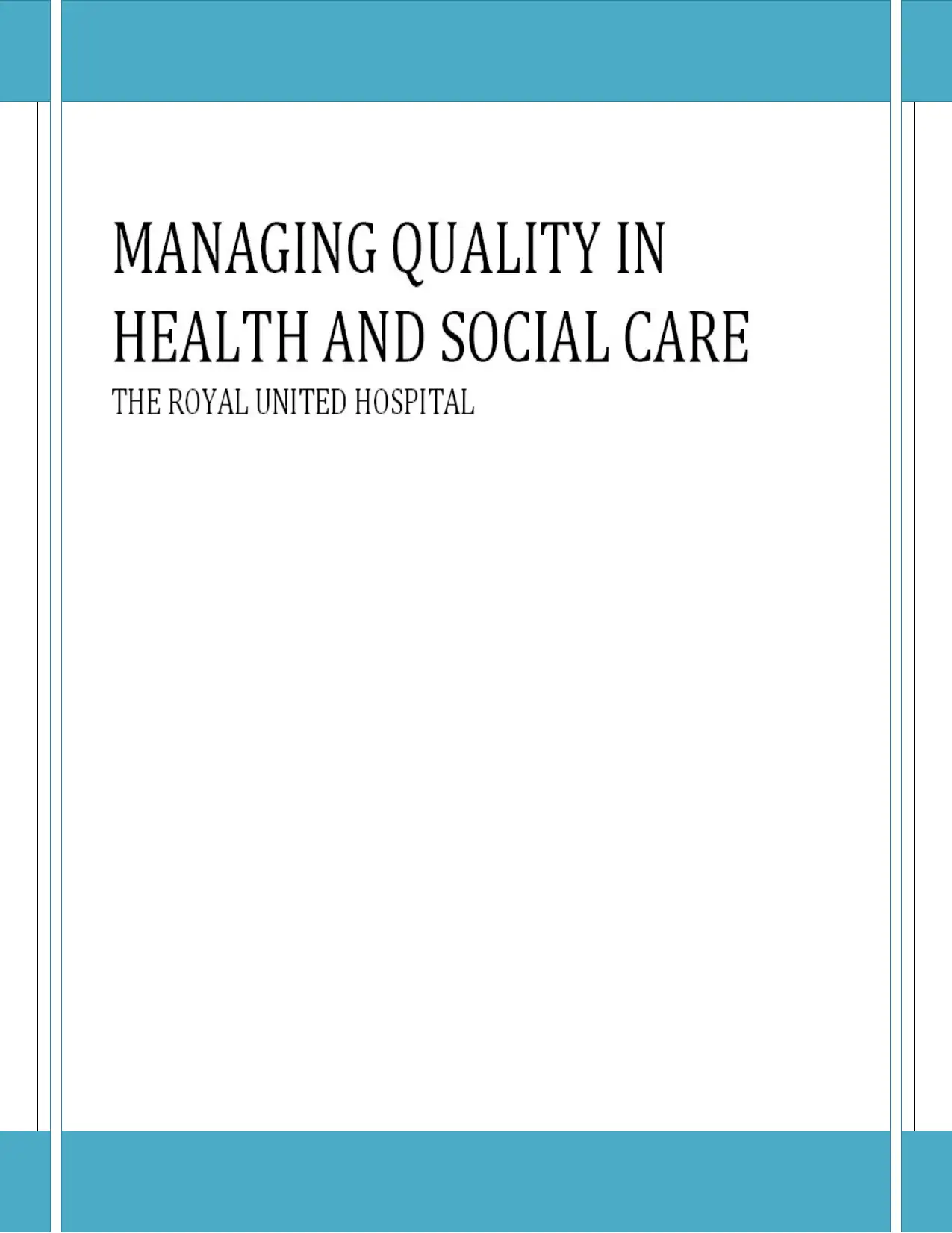
Secure Best Marks with AI Grader
Need help grading? Try our AI Grader for instant feedback on your assignments.
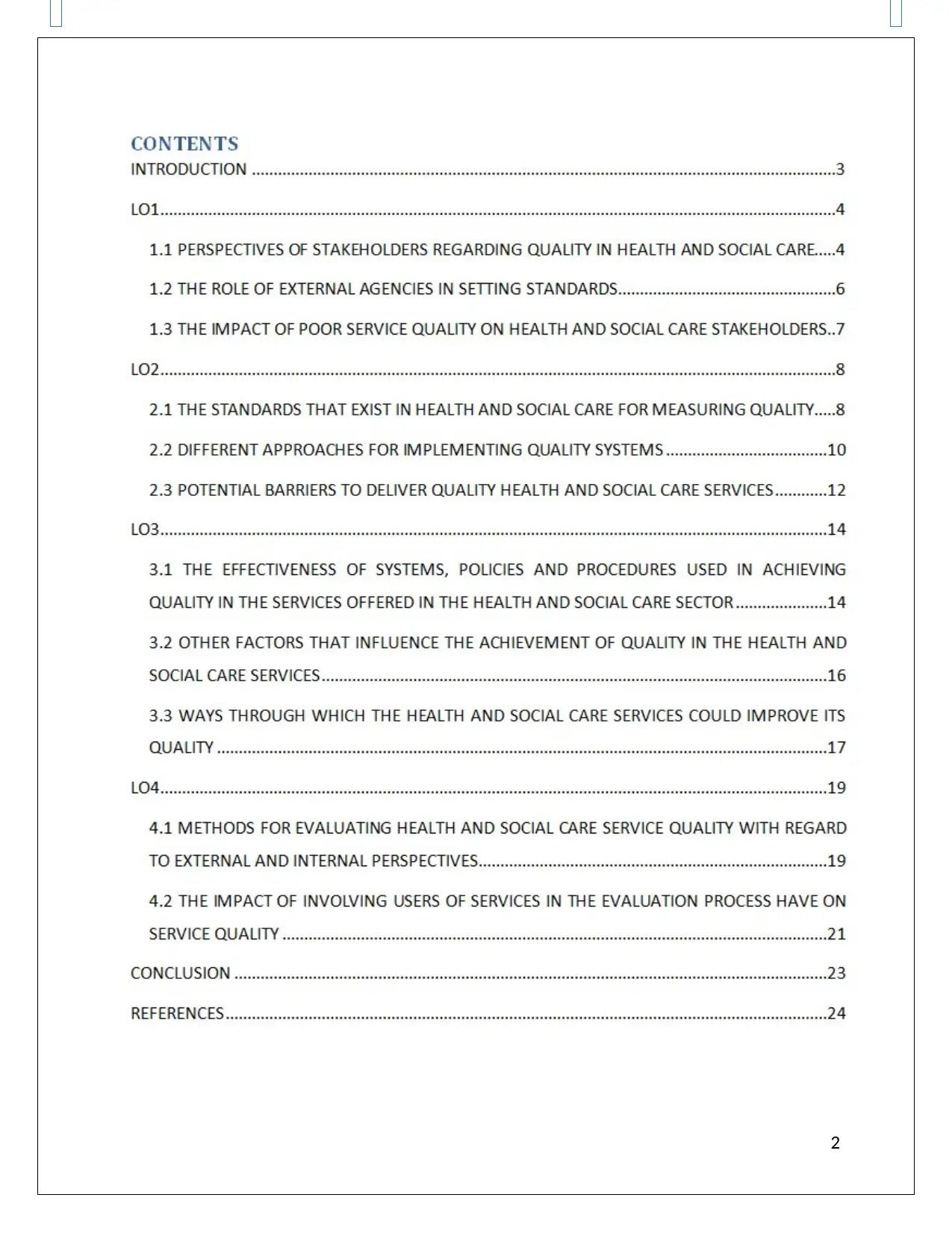
2
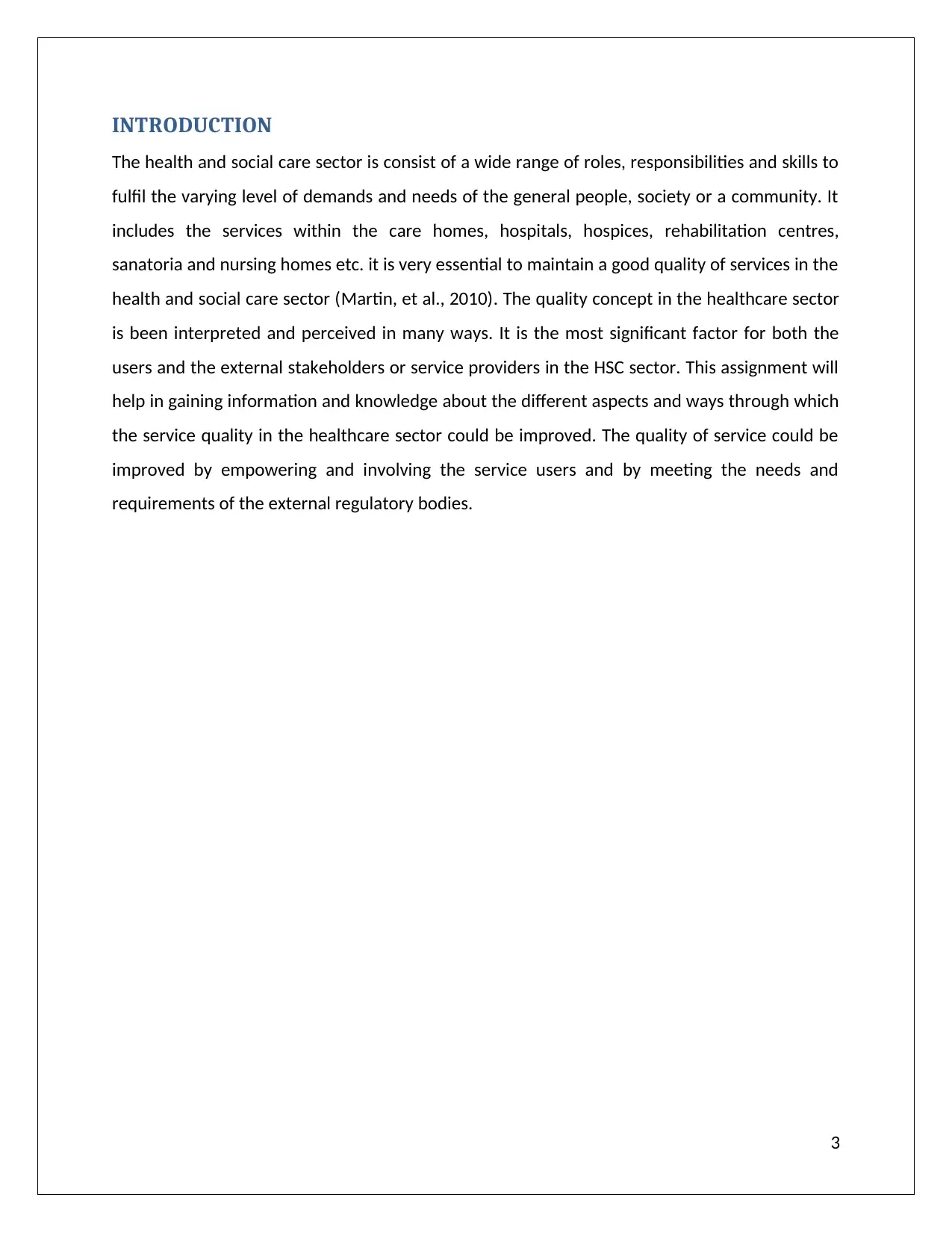
INTRODUCTION
The health and social care sector is consist of a wide range of roles, responsibilities and skills to
fulfil the varying level of demands and needs of the general people, society or a community. It
includes the services within the care homes, hospitals, hospices, rehabilitation centres,
sanatoria and nursing homes etc. it is very essential to maintain a good quality of services in the
health and social care sector (Martin, et al., 2010). The quality concept in the healthcare sector
is been interpreted and perceived in many ways. It is the most significant factor for both the
users and the external stakeholders or service providers in the HSC sector. This assignment will
help in gaining information and knowledge about the different aspects and ways through which
the service quality in the healthcare sector could be improved. The quality of service could be
improved by empowering and involving the service users and by meeting the needs and
requirements of the external regulatory bodies.
3
The health and social care sector is consist of a wide range of roles, responsibilities and skills to
fulfil the varying level of demands and needs of the general people, society or a community. It
includes the services within the care homes, hospitals, hospices, rehabilitation centres,
sanatoria and nursing homes etc. it is very essential to maintain a good quality of services in the
health and social care sector (Martin, et al., 2010). The quality concept in the healthcare sector
is been interpreted and perceived in many ways. It is the most significant factor for both the
users and the external stakeholders or service providers in the HSC sector. This assignment will
help in gaining information and knowledge about the different aspects and ways through which
the service quality in the healthcare sector could be improved. The quality of service could be
improved by empowering and involving the service users and by meeting the needs and
requirements of the external regulatory bodies.
3
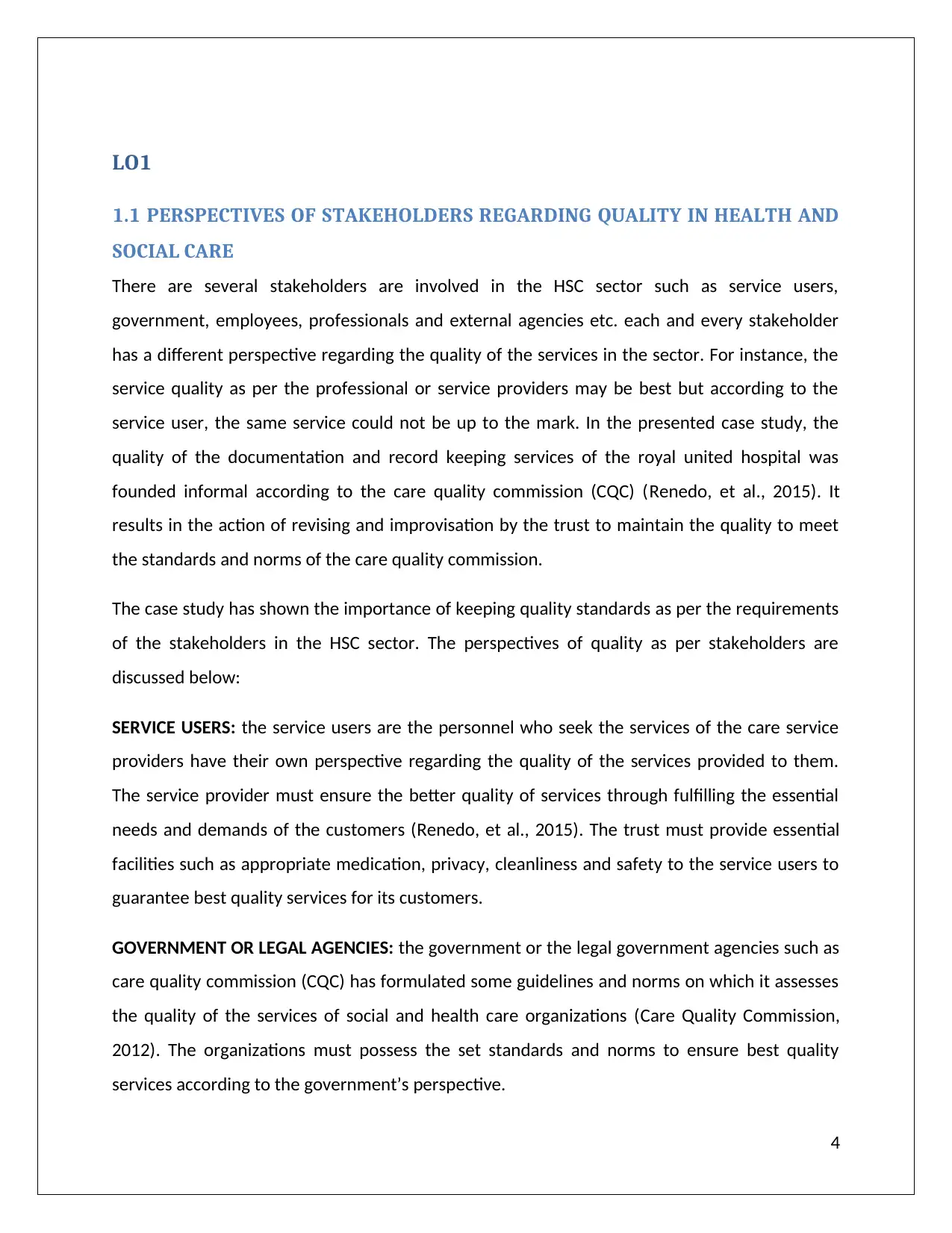
LO1
1.1 PERSPECTIVES OF STAKEHOLDERS REGARDING QUALITY IN HEALTH AND
SOCIAL CARE
There are several stakeholders are involved in the HSC sector such as service users,
government, employees, professionals and external agencies etc. each and every stakeholder
has a different perspective regarding the quality of the services in the sector. For instance, the
service quality as per the professional or service providers may be best but according to the
service user, the same service could not be up to the mark. In the presented case study, the
quality of the documentation and record keeping services of the royal united hospital was
founded informal according to the care quality commission (CQC) (Renedo, et al., 2015). It
results in the action of revising and improvisation by the trust to maintain the quality to meet
the standards and norms of the care quality commission.
The case study has shown the importance of keeping quality standards as per the requirements
of the stakeholders in the HSC sector. The perspectives of quality as per stakeholders are
discussed below:
SERVICE USERS: the service users are the personnel who seek the services of the care service
providers have their own perspective regarding the quality of the services provided to them.
The service provider must ensure the better quality of services through fulfilling the essential
needs and demands of the customers (Renedo, et al., 2015). The trust must provide essential
facilities such as appropriate medication, privacy, cleanliness and safety to the service users to
guarantee best quality services for its customers.
GOVERNMENT OR LEGAL AGENCIES: the government or the legal government agencies such as
care quality commission (CQC) has formulated some guidelines and norms on which it assesses
the quality of the services of social and health care organizations (Care Quality Commission,
2012). The organizations must possess the set standards and norms to ensure best quality
services according to the government’s perspective.
4
1.1 PERSPECTIVES OF STAKEHOLDERS REGARDING QUALITY IN HEALTH AND
SOCIAL CARE
There are several stakeholders are involved in the HSC sector such as service users,
government, employees, professionals and external agencies etc. each and every stakeholder
has a different perspective regarding the quality of the services in the sector. For instance, the
service quality as per the professional or service providers may be best but according to the
service user, the same service could not be up to the mark. In the presented case study, the
quality of the documentation and record keeping services of the royal united hospital was
founded informal according to the care quality commission (CQC) (Renedo, et al., 2015). It
results in the action of revising and improvisation by the trust to maintain the quality to meet
the standards and norms of the care quality commission.
The case study has shown the importance of keeping quality standards as per the requirements
of the stakeholders in the HSC sector. The perspectives of quality as per stakeholders are
discussed below:
SERVICE USERS: the service users are the personnel who seek the services of the care service
providers have their own perspective regarding the quality of the services provided to them.
The service provider must ensure the better quality of services through fulfilling the essential
needs and demands of the customers (Renedo, et al., 2015). The trust must provide essential
facilities such as appropriate medication, privacy, cleanliness and safety to the service users to
guarantee best quality services for its customers.
GOVERNMENT OR LEGAL AGENCIES: the government or the legal government agencies such as
care quality commission (CQC) has formulated some guidelines and norms on which it assesses
the quality of the services of social and health care organizations (Care Quality Commission,
2012). The organizations must possess the set standards and norms to ensure best quality
services according to the government’s perspective.
4
Secure Best Marks with AI Grader
Need help grading? Try our AI Grader for instant feedback on your assignments.
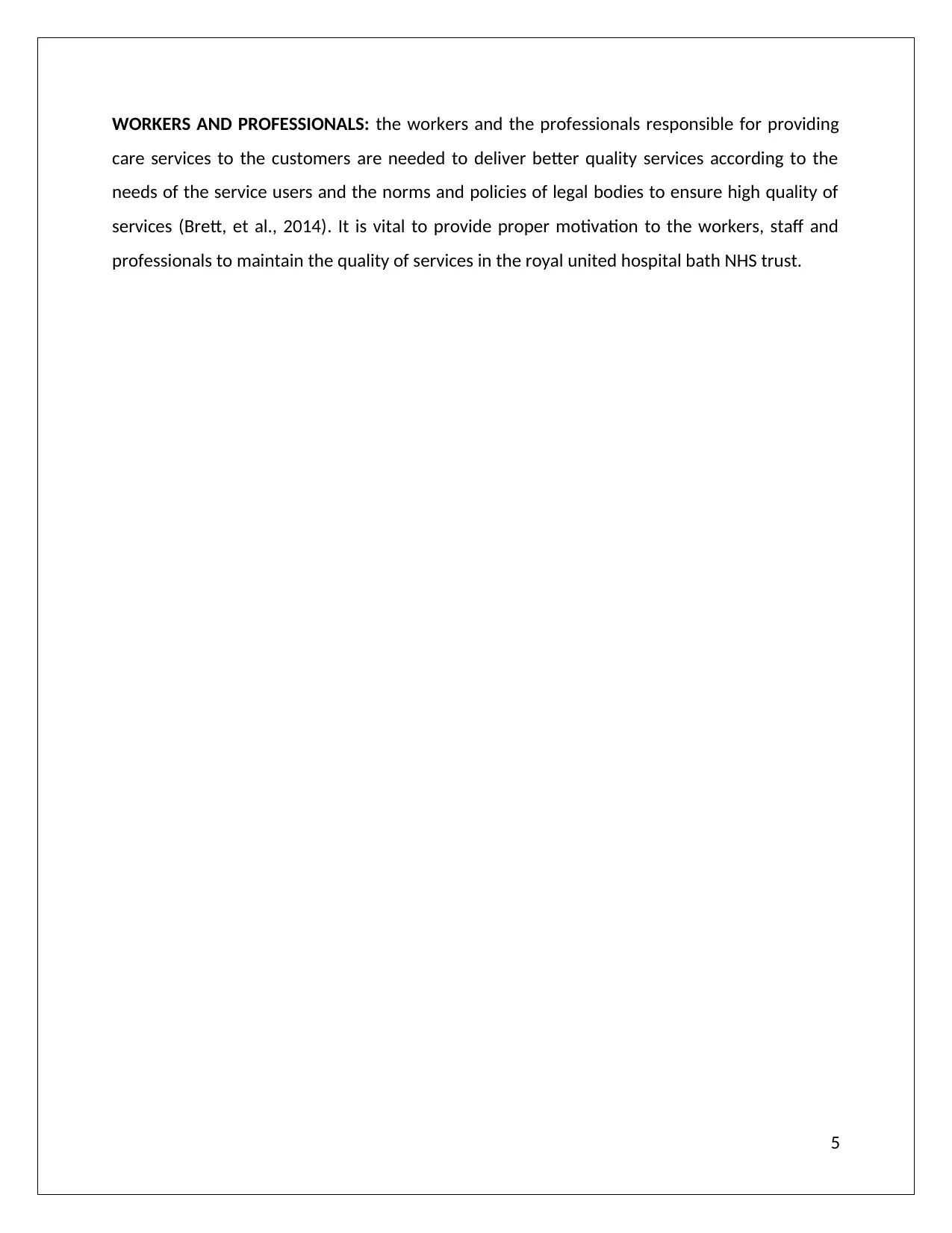
WORKERS AND PROFESSIONALS: the workers and the professionals responsible for providing
care services to the customers are needed to deliver better quality services according to the
needs of the service users and the norms and policies of legal bodies to ensure high quality of
services (Brett, et al., 2014). It is vital to provide proper motivation to the workers, staff and
professionals to maintain the quality of services in the royal united hospital bath NHS trust.
5
care services to the customers are needed to deliver better quality services according to the
needs of the service users and the norms and policies of legal bodies to ensure high quality of
services (Brett, et al., 2014). It is vital to provide proper motivation to the workers, staff and
professionals to maintain the quality of services in the royal united hospital bath NHS trust.
5
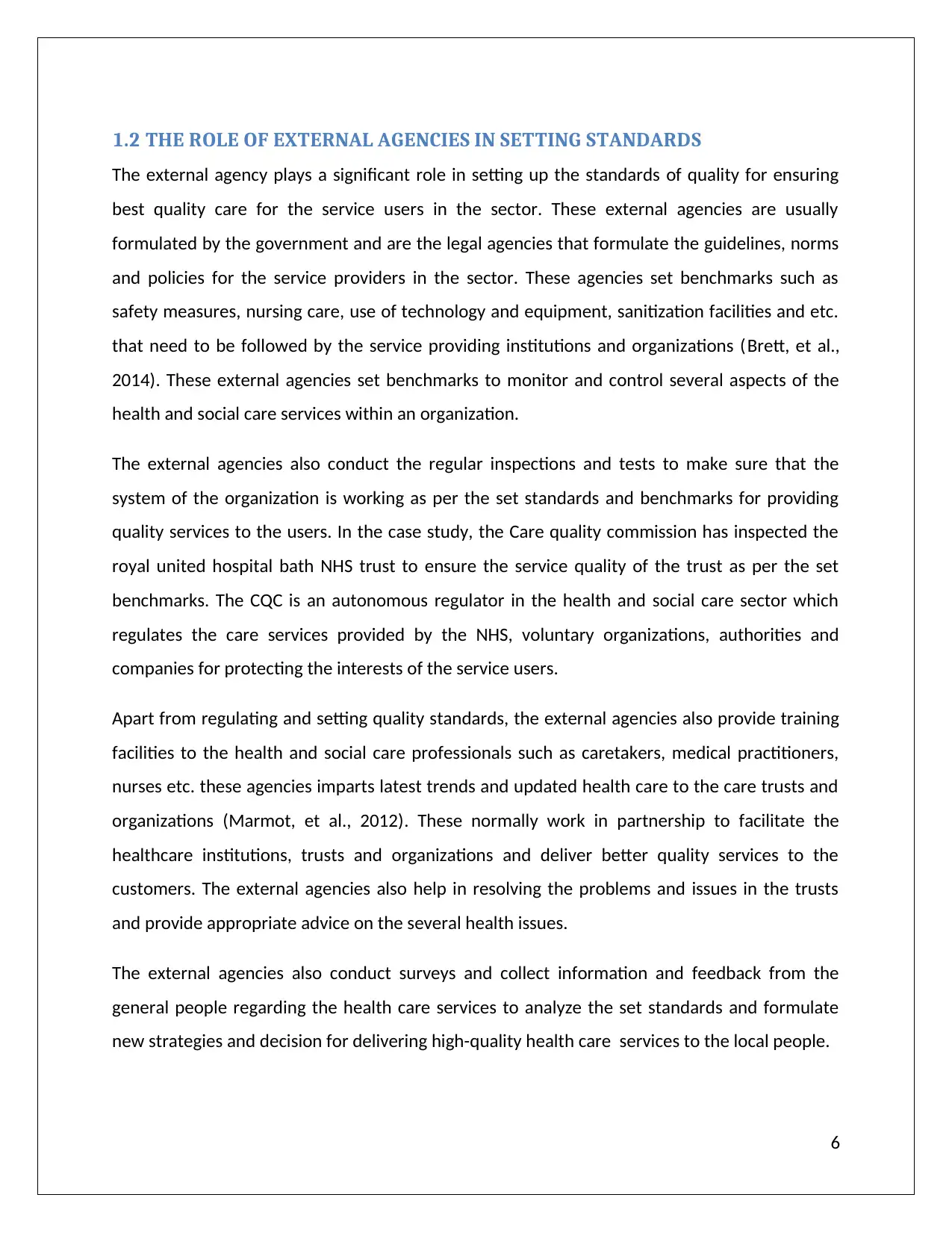
1.2 THE ROLE OF EXTERNAL AGENCIES IN SETTING STANDARDS
The external agency plays a significant role in setting up the standards of quality for ensuring
best quality care for the service users in the sector. These external agencies are usually
formulated by the government and are the legal agencies that formulate the guidelines, norms
and policies for the service providers in the sector. These agencies set benchmarks such as
safety measures, nursing care, use of technology and equipment, sanitization facilities and etc.
that need to be followed by the service providing institutions and organizations (Brett, et al.,
2014). These external agencies set benchmarks to monitor and control several aspects of the
health and social care services within an organization.
The external agencies also conduct the regular inspections and tests to make sure that the
system of the organization is working as per the set standards and benchmarks for providing
quality services to the users. In the case study, the Care quality commission has inspected the
royal united hospital bath NHS trust to ensure the service quality of the trust as per the set
benchmarks. The CQC is an autonomous regulator in the health and social care sector which
regulates the care services provided by the NHS, voluntary organizations, authorities and
companies for protecting the interests of the service users.
Apart from regulating and setting quality standards, the external agencies also provide training
facilities to the health and social care professionals such as caretakers, medical practitioners,
nurses etc. these agencies imparts latest trends and updated health care to the care trusts and
organizations (Marmot, et al., 2012). These normally work in partnership to facilitate the
healthcare institutions, trusts and organizations and deliver better quality services to the
customers. The external agencies also help in resolving the problems and issues in the trusts
and provide appropriate advice on the several health issues.
The external agencies also conduct surveys and collect information and feedback from the
general people regarding the health care services to analyze the set standards and formulate
new strategies and decision for delivering high-quality health care services to the local people.
6
The external agency plays a significant role in setting up the standards of quality for ensuring
best quality care for the service users in the sector. These external agencies are usually
formulated by the government and are the legal agencies that formulate the guidelines, norms
and policies for the service providers in the sector. These agencies set benchmarks such as
safety measures, nursing care, use of technology and equipment, sanitization facilities and etc.
that need to be followed by the service providing institutions and organizations (Brett, et al.,
2014). These external agencies set benchmarks to monitor and control several aspects of the
health and social care services within an organization.
The external agencies also conduct the regular inspections and tests to make sure that the
system of the organization is working as per the set standards and benchmarks for providing
quality services to the users. In the case study, the Care quality commission has inspected the
royal united hospital bath NHS trust to ensure the service quality of the trust as per the set
benchmarks. The CQC is an autonomous regulator in the health and social care sector which
regulates the care services provided by the NHS, voluntary organizations, authorities and
companies for protecting the interests of the service users.
Apart from regulating and setting quality standards, the external agencies also provide training
facilities to the health and social care professionals such as caretakers, medical practitioners,
nurses etc. these agencies imparts latest trends and updated health care to the care trusts and
organizations (Marmot, et al., 2012). These normally work in partnership to facilitate the
healthcare institutions, trusts and organizations and deliver better quality services to the
customers. The external agencies also help in resolving the problems and issues in the trusts
and provide appropriate advice on the several health issues.
The external agencies also conduct surveys and collect information and feedback from the
general people regarding the health care services to analyze the set standards and formulate
new strategies and decision for delivering high-quality health care services to the local people.
6
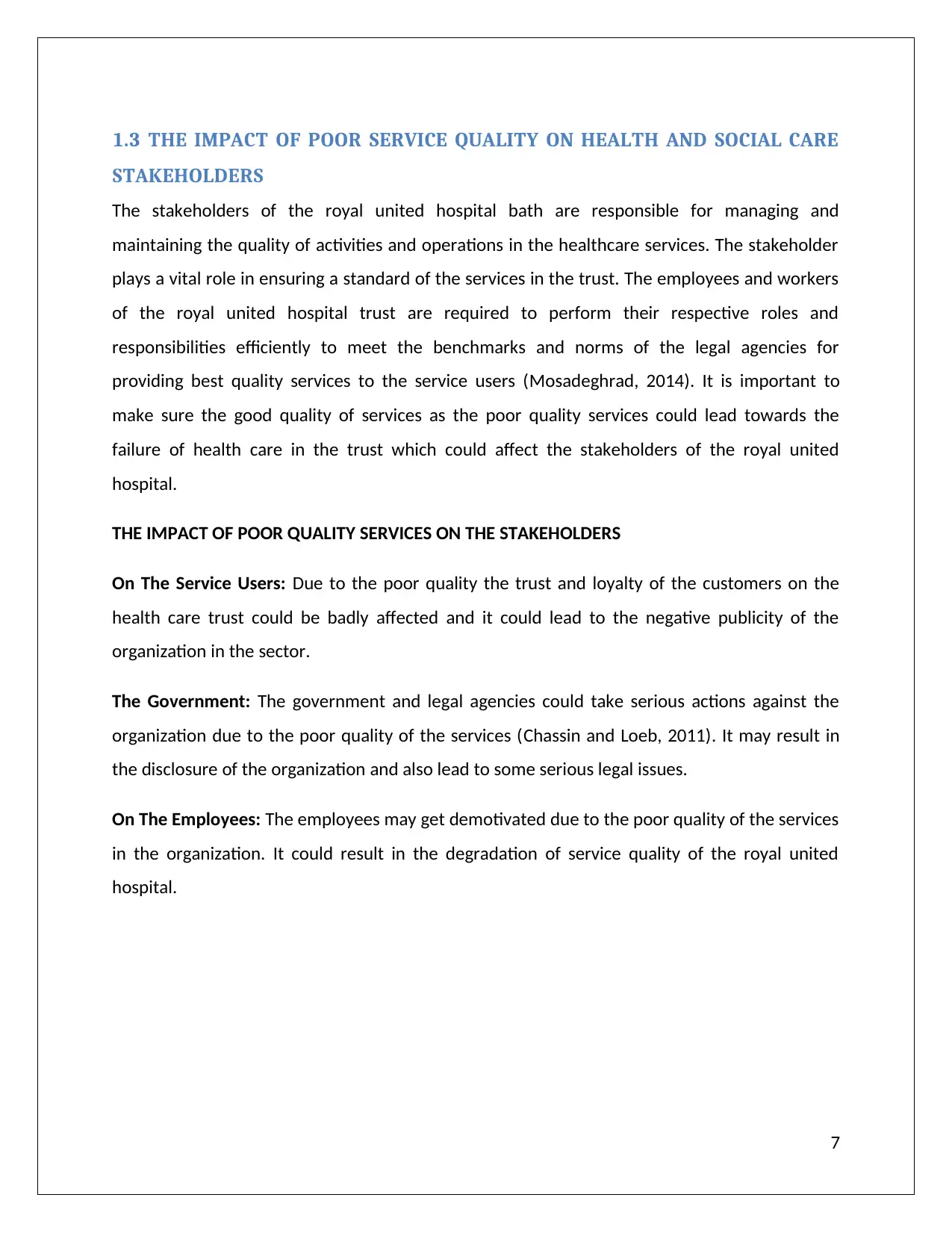
1.3 THE IMPACT OF POOR SERVICE QUALITY ON HEALTH AND SOCIAL CARE
STAKEHOLDERS
The stakeholders of the royal united hospital bath are responsible for managing and
maintaining the quality of activities and operations in the healthcare services. The stakeholder
plays a vital role in ensuring a standard of the services in the trust. The employees and workers
of the royal united hospital trust are required to perform their respective roles and
responsibilities efficiently to meet the benchmarks and norms of the legal agencies for
providing best quality services to the service users (Mosadeghrad, 2014). It is important to
make sure the good quality of services as the poor quality services could lead towards the
failure of health care in the trust which could affect the stakeholders of the royal united
hospital.
THE IMPACT OF POOR QUALITY SERVICES ON THE STAKEHOLDERS
On The Service Users: Due to the poor quality the trust and loyalty of the customers on the
health care trust could be badly affected and it could lead to the negative publicity of the
organization in the sector.
The Government: The government and legal agencies could take serious actions against the
organization due to the poor quality of the services (Chassin and Loeb, 2011). It may result in
the disclosure of the organization and also lead to some serious legal issues.
On The Employees: The employees may get demotivated due to the poor quality of the services
in the organization. It could result in the degradation of service quality of the royal united
hospital.
7
STAKEHOLDERS
The stakeholders of the royal united hospital bath are responsible for managing and
maintaining the quality of activities and operations in the healthcare services. The stakeholder
plays a vital role in ensuring a standard of the services in the trust. The employees and workers
of the royal united hospital trust are required to perform their respective roles and
responsibilities efficiently to meet the benchmarks and norms of the legal agencies for
providing best quality services to the service users (Mosadeghrad, 2014). It is important to
make sure the good quality of services as the poor quality services could lead towards the
failure of health care in the trust which could affect the stakeholders of the royal united
hospital.
THE IMPACT OF POOR QUALITY SERVICES ON THE STAKEHOLDERS
On The Service Users: Due to the poor quality the trust and loyalty of the customers on the
health care trust could be badly affected and it could lead to the negative publicity of the
organization in the sector.
The Government: The government and legal agencies could take serious actions against the
organization due to the poor quality of the services (Chassin and Loeb, 2011). It may result in
the disclosure of the organization and also lead to some serious legal issues.
On The Employees: The employees may get demotivated due to the poor quality of the services
in the organization. It could result in the degradation of service quality of the royal united
hospital.
7
Paraphrase This Document
Need a fresh take? Get an instant paraphrase of this document with our AI Paraphraser
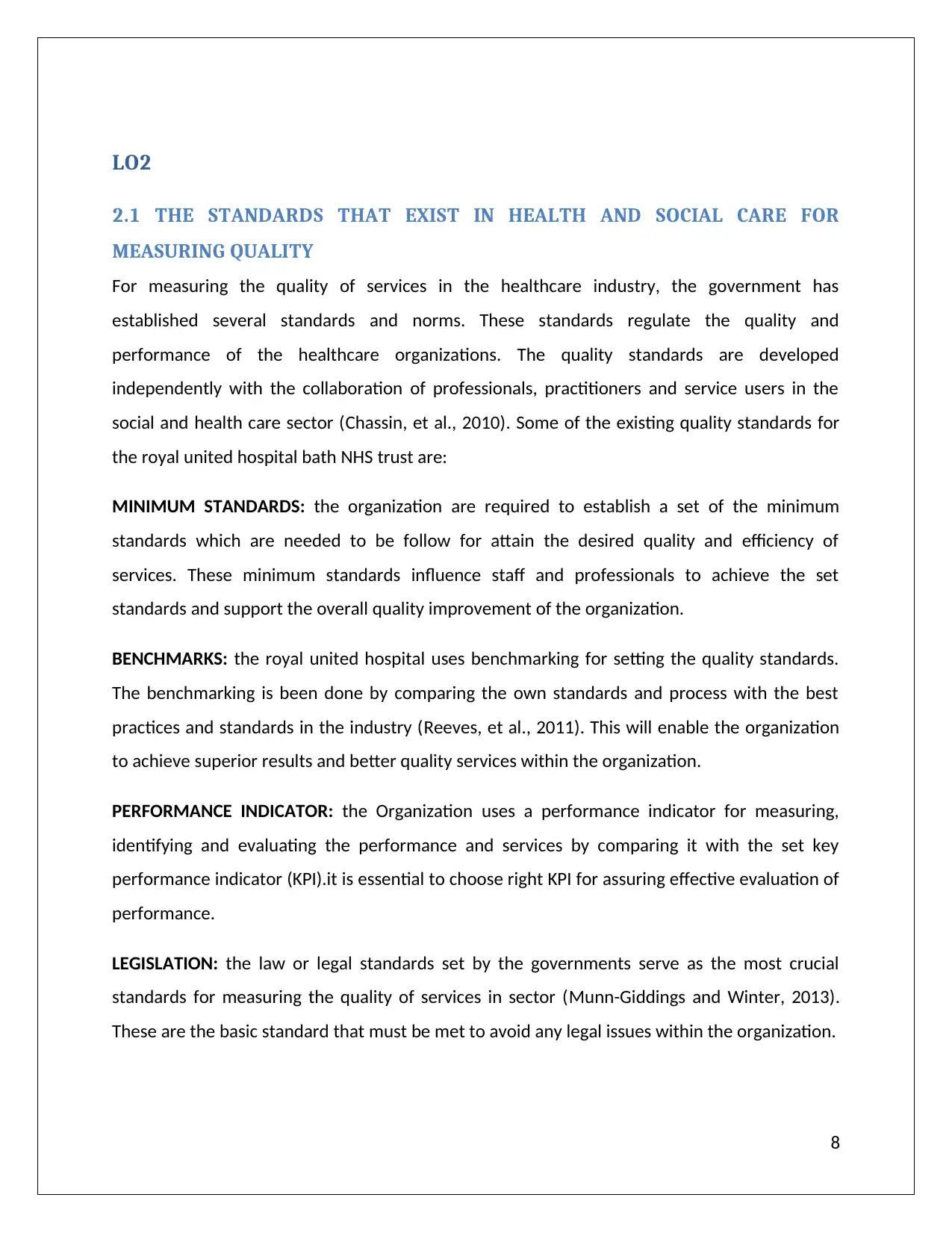
LO2
2.1 THE STANDARDS THAT EXIST IN HEALTH AND SOCIAL CARE FOR
MEASURING QUALITY
For measuring the quality of services in the healthcare industry, the government has
established several standards and norms. These standards regulate the quality and
performance of the healthcare organizations. The quality standards are developed
independently with the collaboration of professionals, practitioners and service users in the
social and health care sector (Chassin, et al., 2010). Some of the existing quality standards for
the royal united hospital bath NHS trust are:
MINIMUM STANDARDS: the organization are required to establish a set of the minimum
standards which are needed to be follow for attain the desired quality and efficiency of
services. These minimum standards influence staff and professionals to achieve the set
standards and support the overall quality improvement of the organization.
BENCHMARKS: the royal united hospital uses benchmarking for setting the quality standards.
The benchmarking is been done by comparing the own standards and process with the best
practices and standards in the industry (Reeves, et al., 2011). This will enable the organization
to achieve superior results and better quality services within the organization.
PERFORMANCE INDICATOR: the Organization uses a performance indicator for measuring,
identifying and evaluating the performance and services by comparing it with the set key
performance indicator (KPI).it is essential to choose right KPI for assuring effective evaluation of
performance.
LEGISLATION: the law or legal standards set by the governments serve as the most crucial
standards for measuring the quality of services in sector (Munn-Giddings and Winter, 2013).
These are the basic standard that must be met to avoid any legal issues within the organization.
8
2.1 THE STANDARDS THAT EXIST IN HEALTH AND SOCIAL CARE FOR
MEASURING QUALITY
For measuring the quality of services in the healthcare industry, the government has
established several standards and norms. These standards regulate the quality and
performance of the healthcare organizations. The quality standards are developed
independently with the collaboration of professionals, practitioners and service users in the
social and health care sector (Chassin, et al., 2010). Some of the existing quality standards for
the royal united hospital bath NHS trust are:
MINIMUM STANDARDS: the organization are required to establish a set of the minimum
standards which are needed to be follow for attain the desired quality and efficiency of
services. These minimum standards influence staff and professionals to achieve the set
standards and support the overall quality improvement of the organization.
BENCHMARKS: the royal united hospital uses benchmarking for setting the quality standards.
The benchmarking is been done by comparing the own standards and process with the best
practices and standards in the industry (Reeves, et al., 2011). This will enable the organization
to achieve superior results and better quality services within the organization.
PERFORMANCE INDICATOR: the Organization uses a performance indicator for measuring,
identifying and evaluating the performance and services by comparing it with the set key
performance indicator (KPI).it is essential to choose right KPI for assuring effective evaluation of
performance.
LEGISLATION: the law or legal standards set by the governments serve as the most crucial
standards for measuring the quality of services in sector (Munn-Giddings and Winter, 2013).
These are the basic standard that must be met to avoid any legal issues within the organization.
8
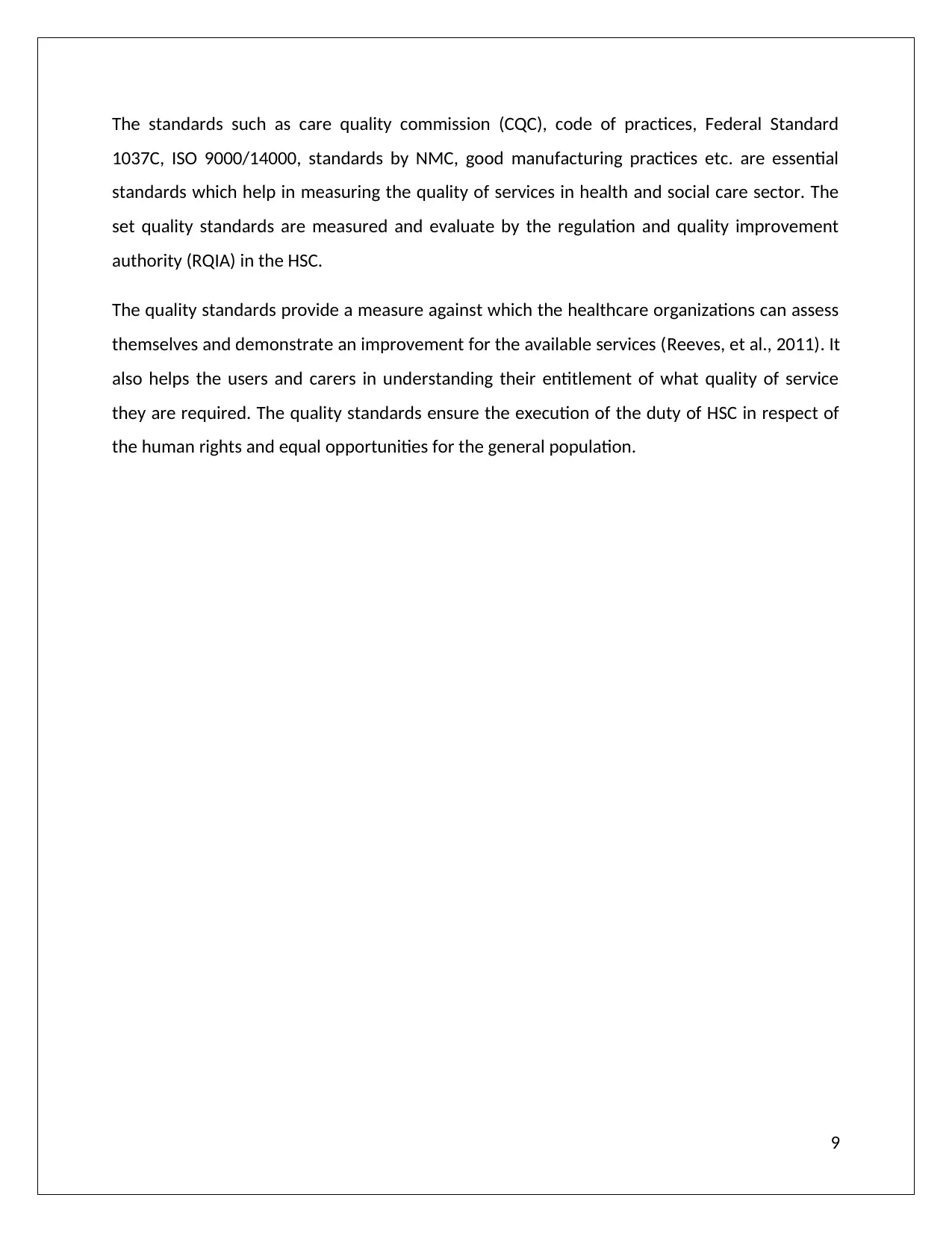
The standards such as care quality commission (CQC), code of practices, Federal Standard
1037C, ISO 9000/14000, standards by NMC, good manufacturing practices etc. are essential
standards which help in measuring the quality of services in health and social care sector. The
set quality standards are measured and evaluate by the regulation and quality improvement
authority (RQIA) in the HSC.
The quality standards provide a measure against which the healthcare organizations can assess
themselves and demonstrate an improvement for the available services (Reeves, et al., 2011). It
also helps the users and carers in understanding their entitlement of what quality of service
they are required. The quality standards ensure the execution of the duty of HSC in respect of
the human rights and equal opportunities for the general population.
9
1037C, ISO 9000/14000, standards by NMC, good manufacturing practices etc. are essential
standards which help in measuring the quality of services in health and social care sector. The
set quality standards are measured and evaluate by the regulation and quality improvement
authority (RQIA) in the HSC.
The quality standards provide a measure against which the healthcare organizations can assess
themselves and demonstrate an improvement for the available services (Reeves, et al., 2011). It
also helps the users and carers in understanding their entitlement of what quality of service
they are required. The quality standards ensure the execution of the duty of HSC in respect of
the human rights and equal opportunities for the general population.
9
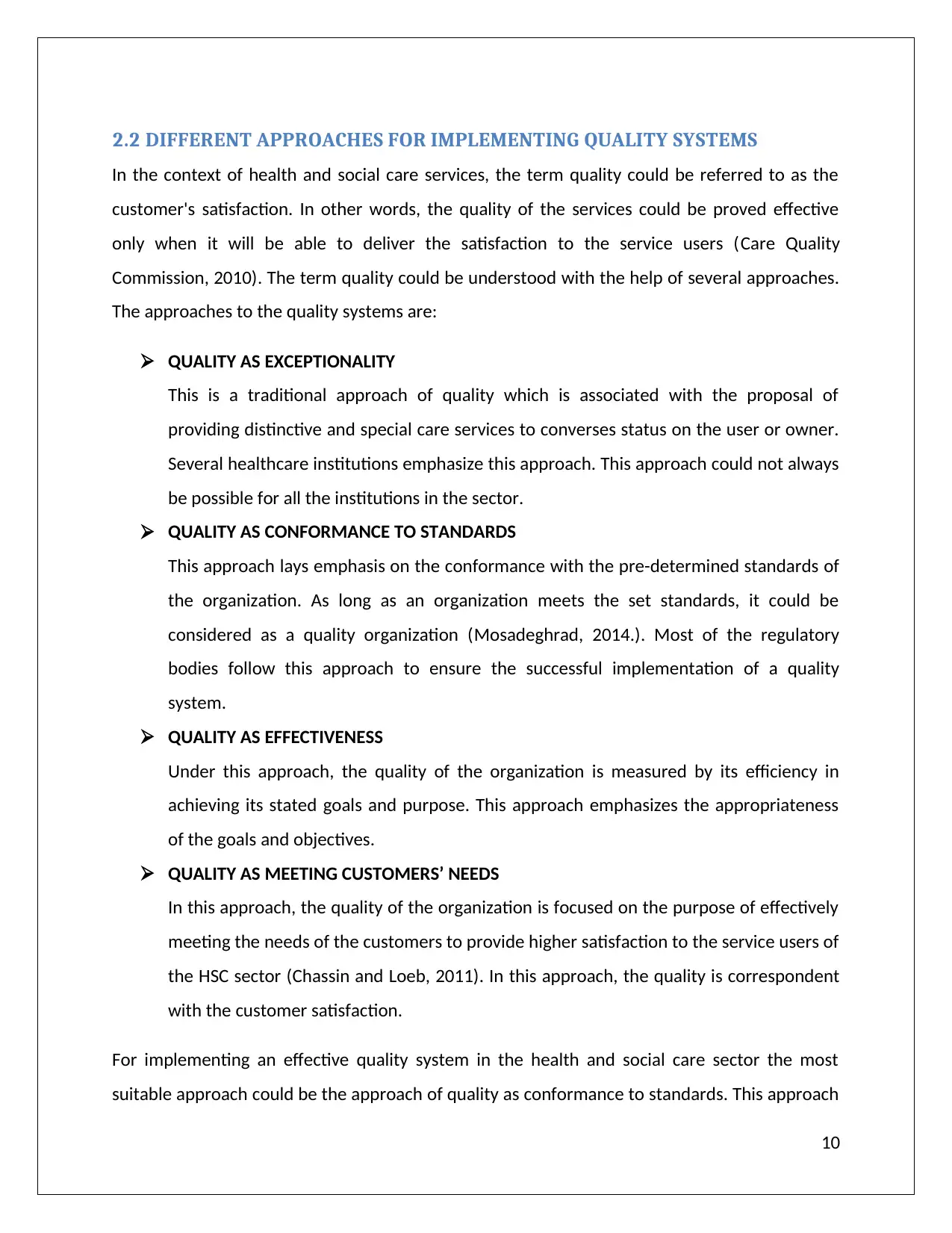
2.2 DIFFERENT APPROACHES FOR IMPLEMENTING QUALITY SYSTEMS
In the context of health and social care services, the term quality could be referred to as the
customer's satisfaction. In other words, the quality of the services could be proved effective
only when it will be able to deliver the satisfaction to the service users (Care Quality
Commission, 2010). The term quality could be understood with the help of several approaches.
The approaches to the quality systems are:
QUALITY AS EXCEPTIONALITY
This is a traditional approach of quality which is associated with the proposal of
providing distinctive and special care services to converses status on the user or owner.
Several healthcare institutions emphasize this approach. This approach could not always
be possible for all the institutions in the sector.
QUALITY AS CONFORMANCE TO STANDARDS
This approach lays emphasis on the conformance with the pre-determined standards of
the organization. As long as an organization meets the set standards, it could be
considered as a quality organization (Mosadeghrad, 2014.). Most of the regulatory
bodies follow this approach to ensure the successful implementation of a quality
system.
QUALITY AS EFFECTIVENESS
Under this approach, the quality of the organization is measured by its efficiency in
achieving its stated goals and purpose. This approach emphasizes the appropriateness
of the goals and objectives.
QUALITY AS MEETING CUSTOMERS’ NEEDS
In this approach, the quality of the organization is focused on the purpose of effectively
meeting the needs of the customers to provide higher satisfaction to the service users of
the HSC sector (Chassin and Loeb, 2011). In this approach, the quality is correspondent
with the customer satisfaction.
For implementing an effective quality system in the health and social care sector the most
suitable approach could be the approach of quality as conformance to standards. This approach
10
In the context of health and social care services, the term quality could be referred to as the
customer's satisfaction. In other words, the quality of the services could be proved effective
only when it will be able to deliver the satisfaction to the service users (Care Quality
Commission, 2010). The term quality could be understood with the help of several approaches.
The approaches to the quality systems are:
QUALITY AS EXCEPTIONALITY
This is a traditional approach of quality which is associated with the proposal of
providing distinctive and special care services to converses status on the user or owner.
Several healthcare institutions emphasize this approach. This approach could not always
be possible for all the institutions in the sector.
QUALITY AS CONFORMANCE TO STANDARDS
This approach lays emphasis on the conformance with the pre-determined standards of
the organization. As long as an organization meets the set standards, it could be
considered as a quality organization (Mosadeghrad, 2014.). Most of the regulatory
bodies follow this approach to ensure the successful implementation of a quality
system.
QUALITY AS EFFECTIVENESS
Under this approach, the quality of the organization is measured by its efficiency in
achieving its stated goals and purpose. This approach emphasizes the appropriateness
of the goals and objectives.
QUALITY AS MEETING CUSTOMERS’ NEEDS
In this approach, the quality of the organization is focused on the purpose of effectively
meeting the needs of the customers to provide higher satisfaction to the service users of
the HSC sector (Chassin and Loeb, 2011). In this approach, the quality is correspondent
with the customer satisfaction.
For implementing an effective quality system in the health and social care sector the most
suitable approach could be the approach of quality as conformance to standards. This approach
10
Secure Best Marks with AI Grader
Need help grading? Try our AI Grader for instant feedback on your assignments.
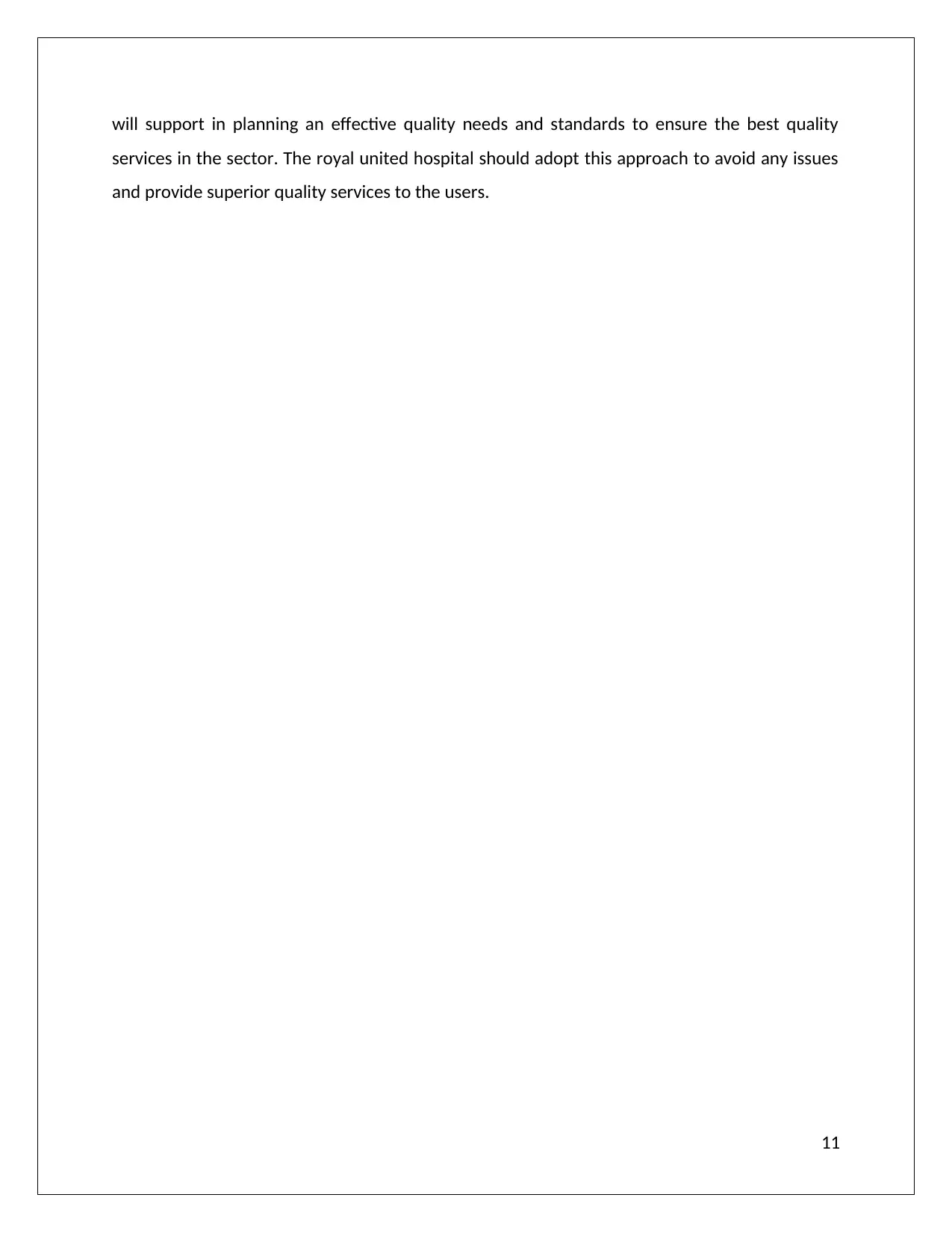
will support in planning an effective quality needs and standards to ensure the best quality
services in the sector. The royal united hospital should adopt this approach to avoid any issues
and provide superior quality services to the users.
11
services in the sector. The royal united hospital should adopt this approach to avoid any issues
and provide superior quality services to the users.
11
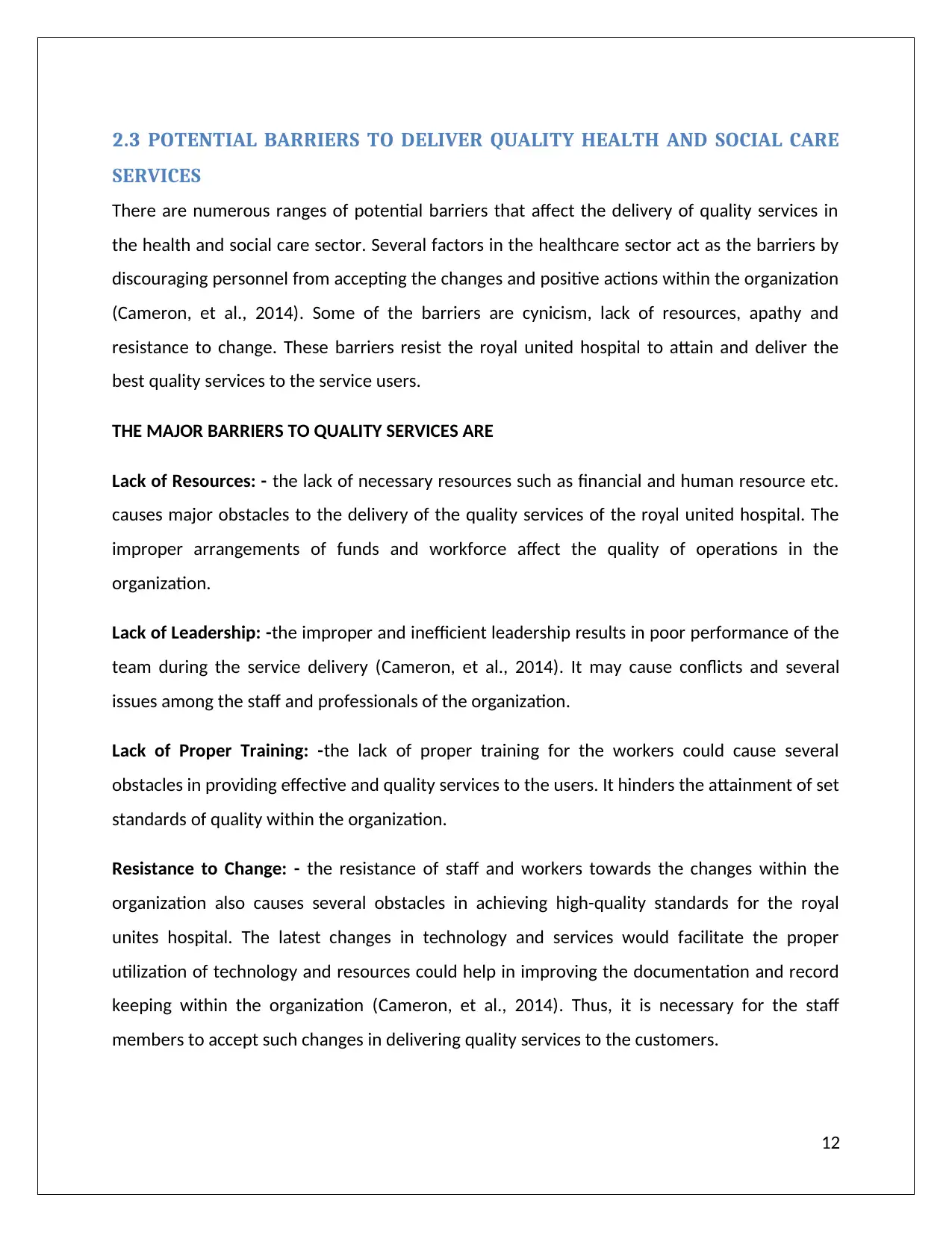
2.3 POTENTIAL BARRIERS TO DELIVER QUALITY HEALTH AND SOCIAL CARE
SERVICES
There are numerous ranges of potential barriers that affect the delivery of quality services in
the health and social care sector. Several factors in the healthcare sector act as the barriers by
discouraging personnel from accepting the changes and positive actions within the organization
(Cameron, et al., 2014). Some of the barriers are cynicism, lack of resources, apathy and
resistance to change. These barriers resist the royal united hospital to attain and deliver the
best quality services to the service users.
THE MAJOR BARRIERS TO QUALITY SERVICES ARE
Lack of Resources: - the lack of necessary resources such as financial and human resource etc.
causes major obstacles to the delivery of the quality services of the royal united hospital. The
improper arrangements of funds and workforce affect the quality of operations in the
organization.
Lack of Leadership: -the improper and inefficient leadership results in poor performance of the
team during the service delivery (Cameron, et al., 2014). It may cause conflicts and several
issues among the staff and professionals of the organization.
Lack of Proper Training: -the lack of proper training for the workers could cause several
obstacles in providing effective and quality services to the users. It hinders the attainment of set
standards of quality within the organization.
Resistance to Change: - the resistance of staff and workers towards the changes within the
organization also causes several obstacles in achieving high-quality standards for the royal
unites hospital. The latest changes in technology and services would facilitate the proper
utilization of technology and resources could help in improving the documentation and record
keeping within the organization (Cameron, et al., 2014). Thus, it is necessary for the staff
members to accept such changes in delivering quality services to the customers.
12
SERVICES
There are numerous ranges of potential barriers that affect the delivery of quality services in
the health and social care sector. Several factors in the healthcare sector act as the barriers by
discouraging personnel from accepting the changes and positive actions within the organization
(Cameron, et al., 2014). Some of the barriers are cynicism, lack of resources, apathy and
resistance to change. These barriers resist the royal united hospital to attain and deliver the
best quality services to the service users.
THE MAJOR BARRIERS TO QUALITY SERVICES ARE
Lack of Resources: - the lack of necessary resources such as financial and human resource etc.
causes major obstacles to the delivery of the quality services of the royal united hospital. The
improper arrangements of funds and workforce affect the quality of operations in the
organization.
Lack of Leadership: -the improper and inefficient leadership results in poor performance of the
team during the service delivery (Cameron, et al., 2014). It may cause conflicts and several
issues among the staff and professionals of the organization.
Lack of Proper Training: -the lack of proper training for the workers could cause several
obstacles in providing effective and quality services to the users. It hinders the attainment of set
standards of quality within the organization.
Resistance to Change: - the resistance of staff and workers towards the changes within the
organization also causes several obstacles in achieving high-quality standards for the royal
unites hospital. The latest changes in technology and services would facilitate the proper
utilization of technology and resources could help in improving the documentation and record
keeping within the organization (Cameron, et al., 2014). Thus, it is necessary for the staff
members to accept such changes in delivering quality services to the customers.
12
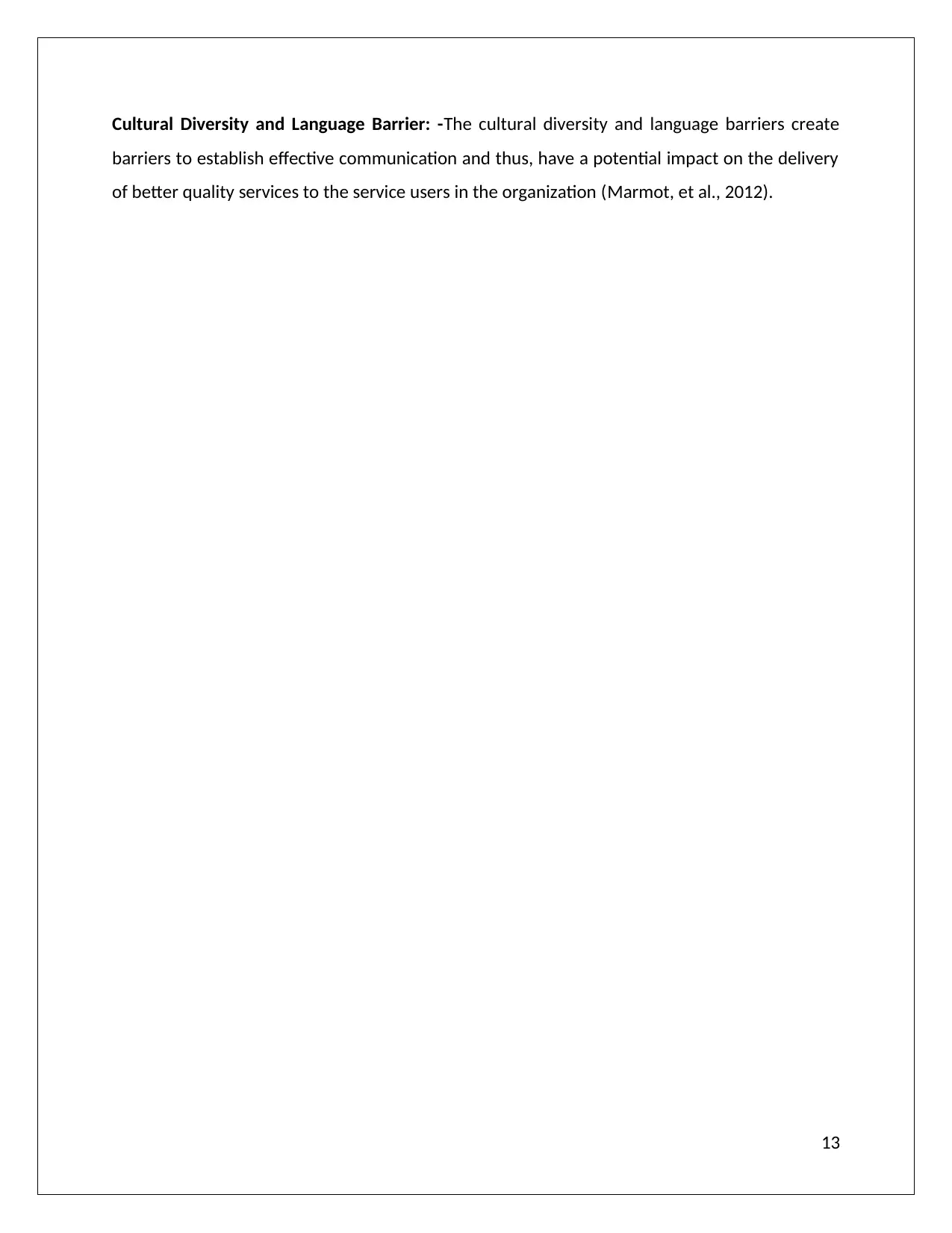
Cultural Diversity and Language Barrier: -The cultural diversity and language barriers create
barriers to establish effective communication and thus, have a potential impact on the delivery
of better quality services to the service users in the organization (Marmot, et al., 2012).
13
barriers to establish effective communication and thus, have a potential impact on the delivery
of better quality services to the service users in the organization (Marmot, et al., 2012).
13
Paraphrase This Document
Need a fresh take? Get an instant paraphrase of this document with our AI Paraphraser
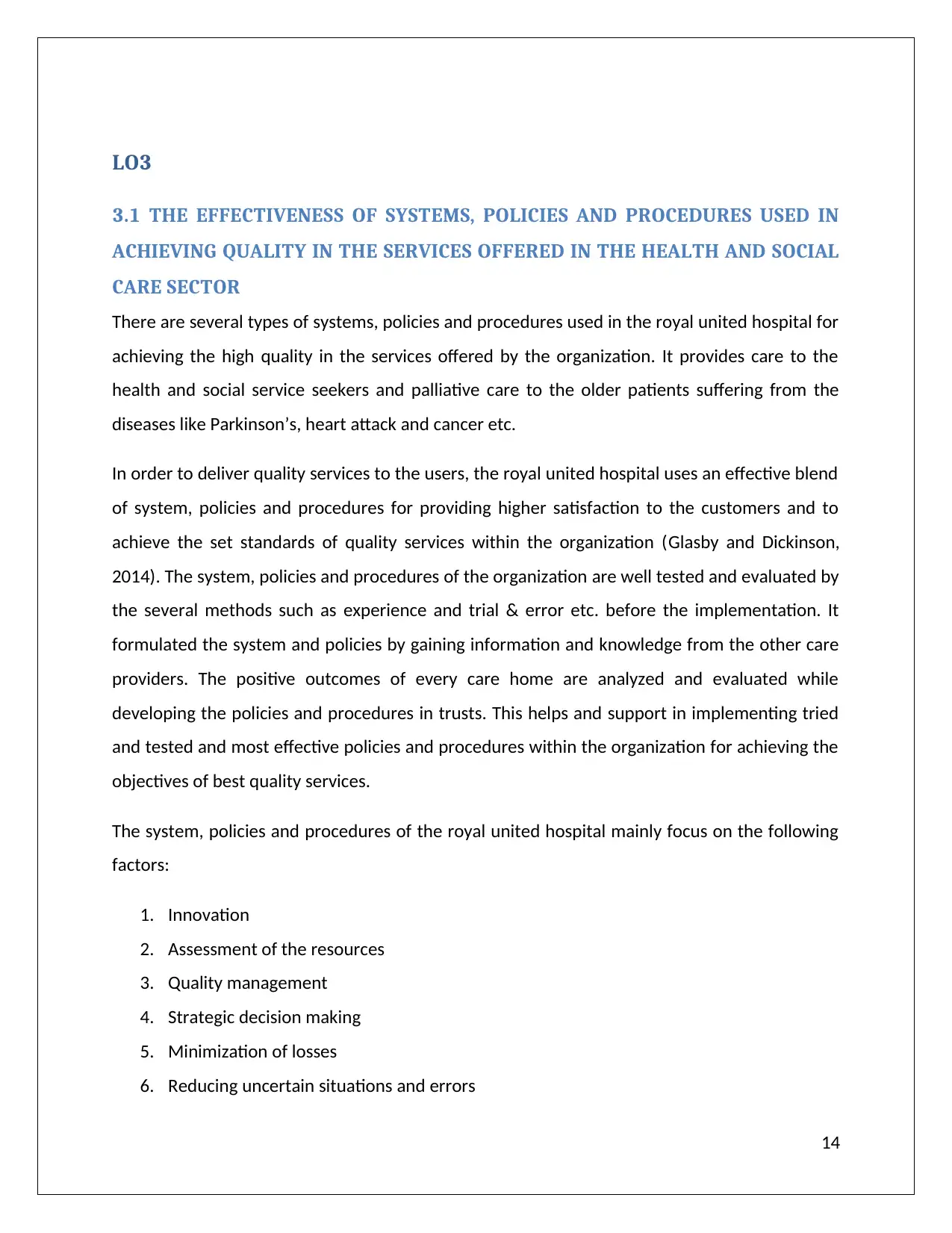
LO3
3.1 THE EFFECTIVENESS OF SYSTEMS, POLICIES AND PROCEDURES USED IN
ACHIEVING QUALITY IN THE SERVICES OFFERED IN THE HEALTH AND SOCIAL
CARE SECTOR
There are several types of systems, policies and procedures used in the royal united hospital for
achieving the high quality in the services offered by the organization. It provides care to the
health and social service seekers and palliative care to the older patients suffering from the
diseases like Parkinson’s, heart attack and cancer etc.
In order to deliver quality services to the users, the royal united hospital uses an effective blend
of system, policies and procedures for providing higher satisfaction to the customers and to
achieve the set standards of quality services within the organization (Glasby and Dickinson,
2014). The system, policies and procedures of the organization are well tested and evaluated by
the several methods such as experience and trial & error etc. before the implementation. It
formulated the system and policies by gaining information and knowledge from the other care
providers. The positive outcomes of every care home are analyzed and evaluated while
developing the policies and procedures in trusts. This helps and support in implementing tried
and tested and most effective policies and procedures within the organization for achieving the
objectives of best quality services.
The system, policies and procedures of the royal united hospital mainly focus on the following
factors:
1. Innovation
2. Assessment of the resources
3. Quality management
4. Strategic decision making
5. Minimization of losses
6. Reducing uncertain situations and errors
14
3.1 THE EFFECTIVENESS OF SYSTEMS, POLICIES AND PROCEDURES USED IN
ACHIEVING QUALITY IN THE SERVICES OFFERED IN THE HEALTH AND SOCIAL
CARE SECTOR
There are several types of systems, policies and procedures used in the royal united hospital for
achieving the high quality in the services offered by the organization. It provides care to the
health and social service seekers and palliative care to the older patients suffering from the
diseases like Parkinson’s, heart attack and cancer etc.
In order to deliver quality services to the users, the royal united hospital uses an effective blend
of system, policies and procedures for providing higher satisfaction to the customers and to
achieve the set standards of quality services within the organization (Glasby and Dickinson,
2014). The system, policies and procedures of the organization are well tested and evaluated by
the several methods such as experience and trial & error etc. before the implementation. It
formulated the system and policies by gaining information and knowledge from the other care
providers. The positive outcomes of every care home are analyzed and evaluated while
developing the policies and procedures in trusts. This helps and support in implementing tried
and tested and most effective policies and procedures within the organization for achieving the
objectives of best quality services.
The system, policies and procedures of the royal united hospital mainly focus on the following
factors:
1. Innovation
2. Assessment of the resources
3. Quality management
4. Strategic decision making
5. Minimization of losses
6. Reducing uncertain situations and errors
14
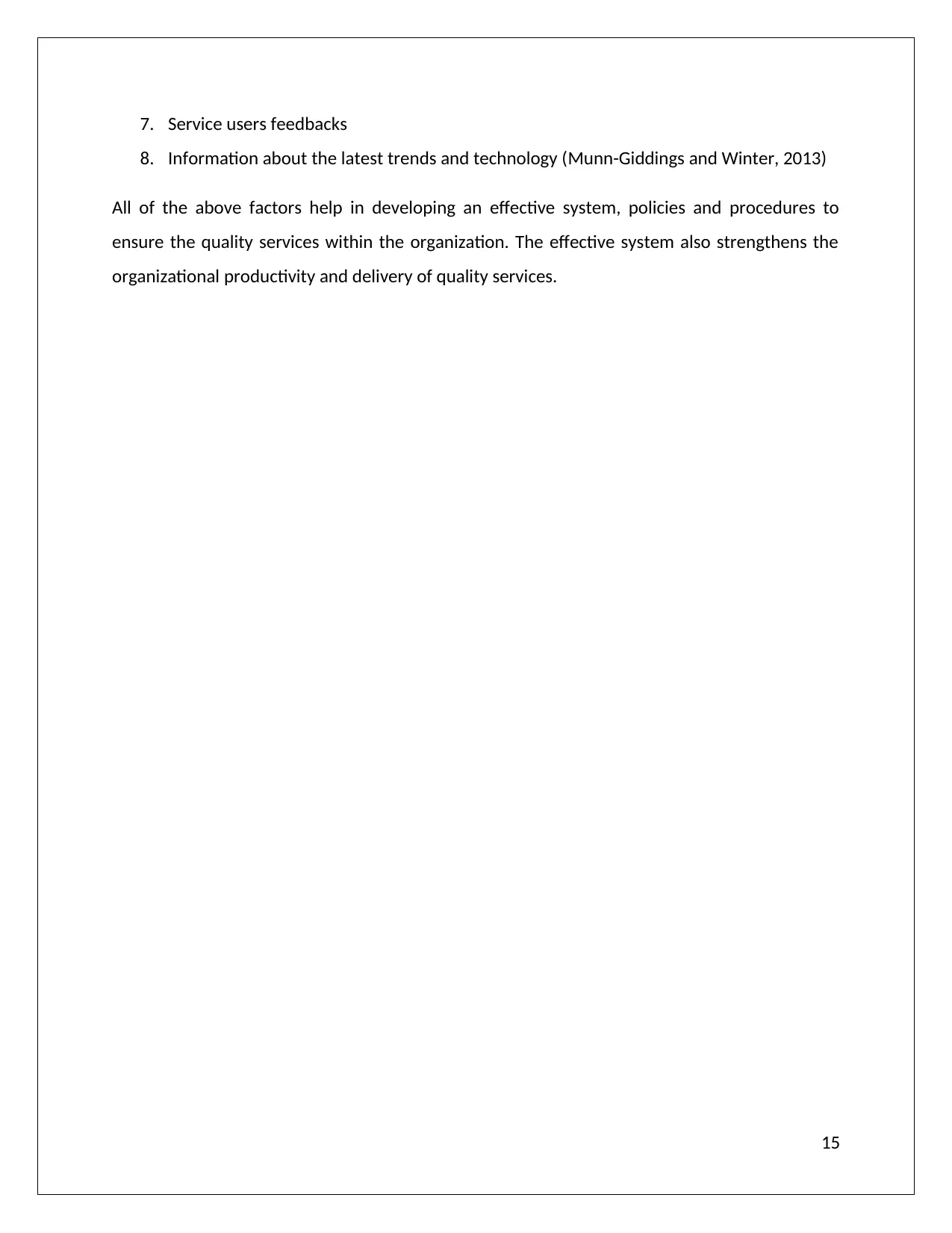
7. Service users feedbacks
8. Information about the latest trends and technology (Munn-Giddings and Winter, 2013)
All of the above factors help in developing an effective system, policies and procedures to
ensure the quality services within the organization. The effective system also strengthens the
organizational productivity and delivery of quality services.
15
8. Information about the latest trends and technology (Munn-Giddings and Winter, 2013)
All of the above factors help in developing an effective system, policies and procedures to
ensure the quality services within the organization. The effective system also strengthens the
organizational productivity and delivery of quality services.
15
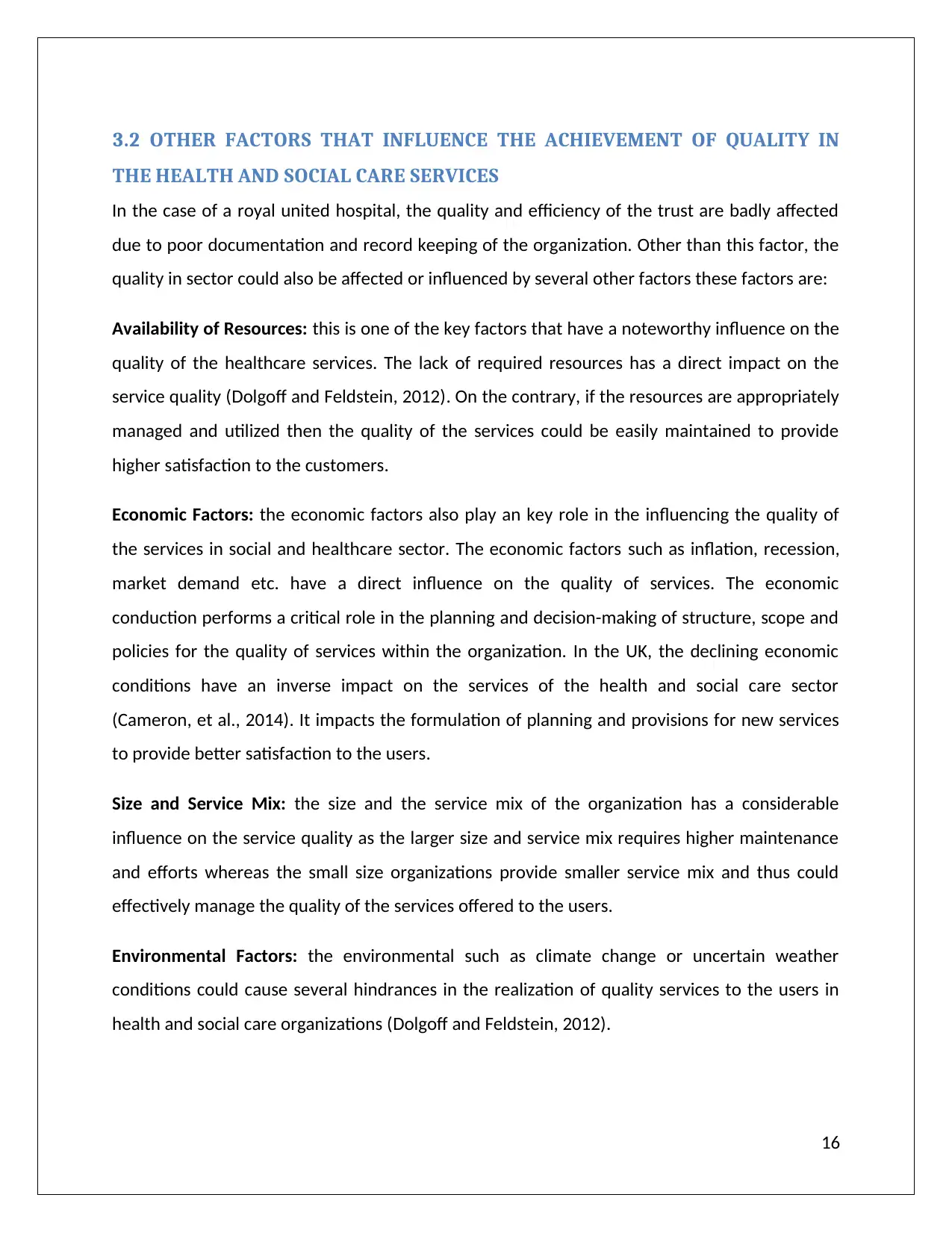
3.2 OTHER FACTORS THAT INFLUENCE THE ACHIEVEMENT OF QUALITY IN
THE HEALTH AND SOCIAL CARE SERVICES
In the case of a royal united hospital, the quality and efficiency of the trust are badly affected
due to poor documentation and record keeping of the organization. Other than this factor, the
quality in sector could also be affected or influenced by several other factors these factors are:
Availability of Resources: this is one of the key factors that have a noteworthy influence on the
quality of the healthcare services. The lack of required resources has a direct impact on the
service quality (Dolgoff and Feldstein, 2012). On the contrary, if the resources are appropriately
managed and utilized then the quality of the services could be easily maintained to provide
higher satisfaction to the customers.
Economic Factors: the economic factors also play an key role in the influencing the quality of
the services in social and healthcare sector. The economic factors such as inflation, recession,
market demand etc. have a direct influence on the quality of services. The economic
conduction performs a critical role in the planning and decision-making of structure, scope and
policies for the quality of services within the organization. In the UK, the declining economic
conditions have an inverse impact on the services of the health and social care sector
(Cameron, et al., 2014). It impacts the formulation of planning and provisions for new services
to provide better satisfaction to the users.
Size and Service Mix: the size and the service mix of the organization has a considerable
influence on the service quality as the larger size and service mix requires higher maintenance
and efforts whereas the small size organizations provide smaller service mix and thus could
effectively manage the quality of the services offered to the users.
Environmental Factors: the environmental such as climate change or uncertain weather
conditions could cause several hindrances in the realization of quality services to the users in
health and social care organizations (Dolgoff and Feldstein, 2012).
16
THE HEALTH AND SOCIAL CARE SERVICES
In the case of a royal united hospital, the quality and efficiency of the trust are badly affected
due to poor documentation and record keeping of the organization. Other than this factor, the
quality in sector could also be affected or influenced by several other factors these factors are:
Availability of Resources: this is one of the key factors that have a noteworthy influence on the
quality of the healthcare services. The lack of required resources has a direct impact on the
service quality (Dolgoff and Feldstein, 2012). On the contrary, if the resources are appropriately
managed and utilized then the quality of the services could be easily maintained to provide
higher satisfaction to the customers.
Economic Factors: the economic factors also play an key role in the influencing the quality of
the services in social and healthcare sector. The economic factors such as inflation, recession,
market demand etc. have a direct influence on the quality of services. The economic
conduction performs a critical role in the planning and decision-making of structure, scope and
policies for the quality of services within the organization. In the UK, the declining economic
conditions have an inverse impact on the services of the health and social care sector
(Cameron, et al., 2014). It impacts the formulation of planning and provisions for new services
to provide better satisfaction to the users.
Size and Service Mix: the size and the service mix of the organization has a considerable
influence on the service quality as the larger size and service mix requires higher maintenance
and efforts whereas the small size organizations provide smaller service mix and thus could
effectively manage the quality of the services offered to the users.
Environmental Factors: the environmental such as climate change or uncertain weather
conditions could cause several hindrances in the realization of quality services to the users in
health and social care organizations (Dolgoff and Feldstein, 2012).
16
Secure Best Marks with AI Grader
Need help grading? Try our AI Grader for instant feedback on your assignments.
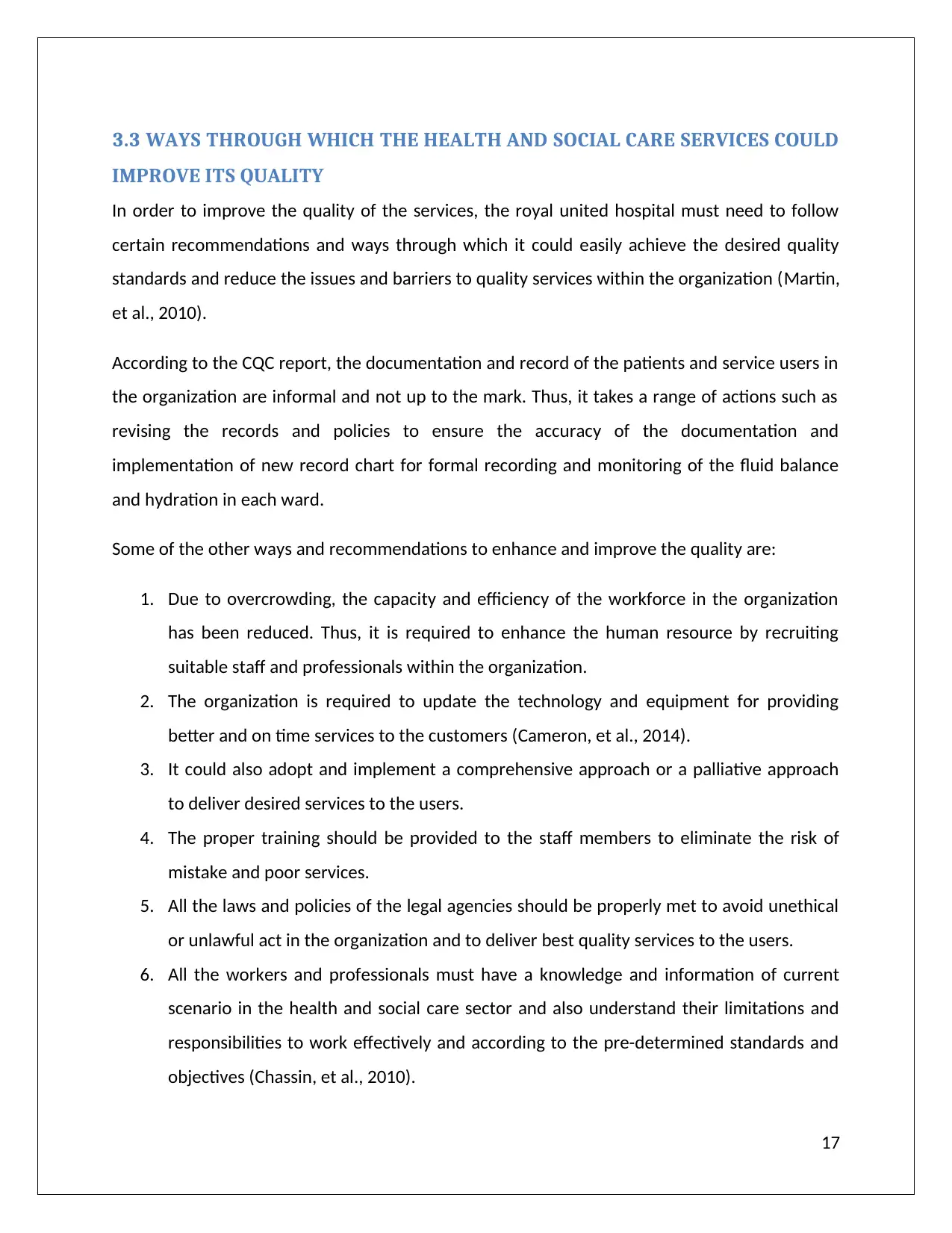
3.3 WAYS THROUGH WHICH THE HEALTH AND SOCIAL CARE SERVICES COULD
IMPROVE ITS QUALITY
In order to improve the quality of the services, the royal united hospital must need to follow
certain recommendations and ways through which it could easily achieve the desired quality
standards and reduce the issues and barriers to quality services within the organization (Martin,
et al., 2010).
According to the CQC report, the documentation and record of the patients and service users in
the organization are informal and not up to the mark. Thus, it takes a range of actions such as
revising the records and policies to ensure the accuracy of the documentation and
implementation of new record chart for formal recording and monitoring of the fluid balance
and hydration in each ward.
Some of the other ways and recommendations to enhance and improve the quality are:
1. Due to overcrowding, the capacity and efficiency of the workforce in the organization
has been reduced. Thus, it is required to enhance the human resource by recruiting
suitable staff and professionals within the organization.
2. The organization is required to update the technology and equipment for providing
better and on time services to the customers (Cameron, et al., 2014).
3. It could also adopt and implement a comprehensive approach or a palliative approach
to deliver desired services to the users.
4. The proper training should be provided to the staff members to eliminate the risk of
mistake and poor services.
5. All the laws and policies of the legal agencies should be properly met to avoid unethical
or unlawful act in the organization and to deliver best quality services to the users.
6. All the workers and professionals must have a knowledge and information of current
scenario in the health and social care sector and also understand their limitations and
responsibilities to work effectively and according to the pre-determined standards and
objectives (Chassin, et al., 2010).
17
IMPROVE ITS QUALITY
In order to improve the quality of the services, the royal united hospital must need to follow
certain recommendations and ways through which it could easily achieve the desired quality
standards and reduce the issues and barriers to quality services within the organization (Martin,
et al., 2010).
According to the CQC report, the documentation and record of the patients and service users in
the organization are informal and not up to the mark. Thus, it takes a range of actions such as
revising the records and policies to ensure the accuracy of the documentation and
implementation of new record chart for formal recording and monitoring of the fluid balance
and hydration in each ward.
Some of the other ways and recommendations to enhance and improve the quality are:
1. Due to overcrowding, the capacity and efficiency of the workforce in the organization
has been reduced. Thus, it is required to enhance the human resource by recruiting
suitable staff and professionals within the organization.
2. The organization is required to update the technology and equipment for providing
better and on time services to the customers (Cameron, et al., 2014).
3. It could also adopt and implement a comprehensive approach or a palliative approach
to deliver desired services to the users.
4. The proper training should be provided to the staff members to eliminate the risk of
mistake and poor services.
5. All the laws and policies of the legal agencies should be properly met to avoid unethical
or unlawful act in the organization and to deliver best quality services to the users.
6. All the workers and professionals must have a knowledge and information of current
scenario in the health and social care sector and also understand their limitations and
responsibilities to work effectively and according to the pre-determined standards and
objectives (Chassin, et al., 2010).
17
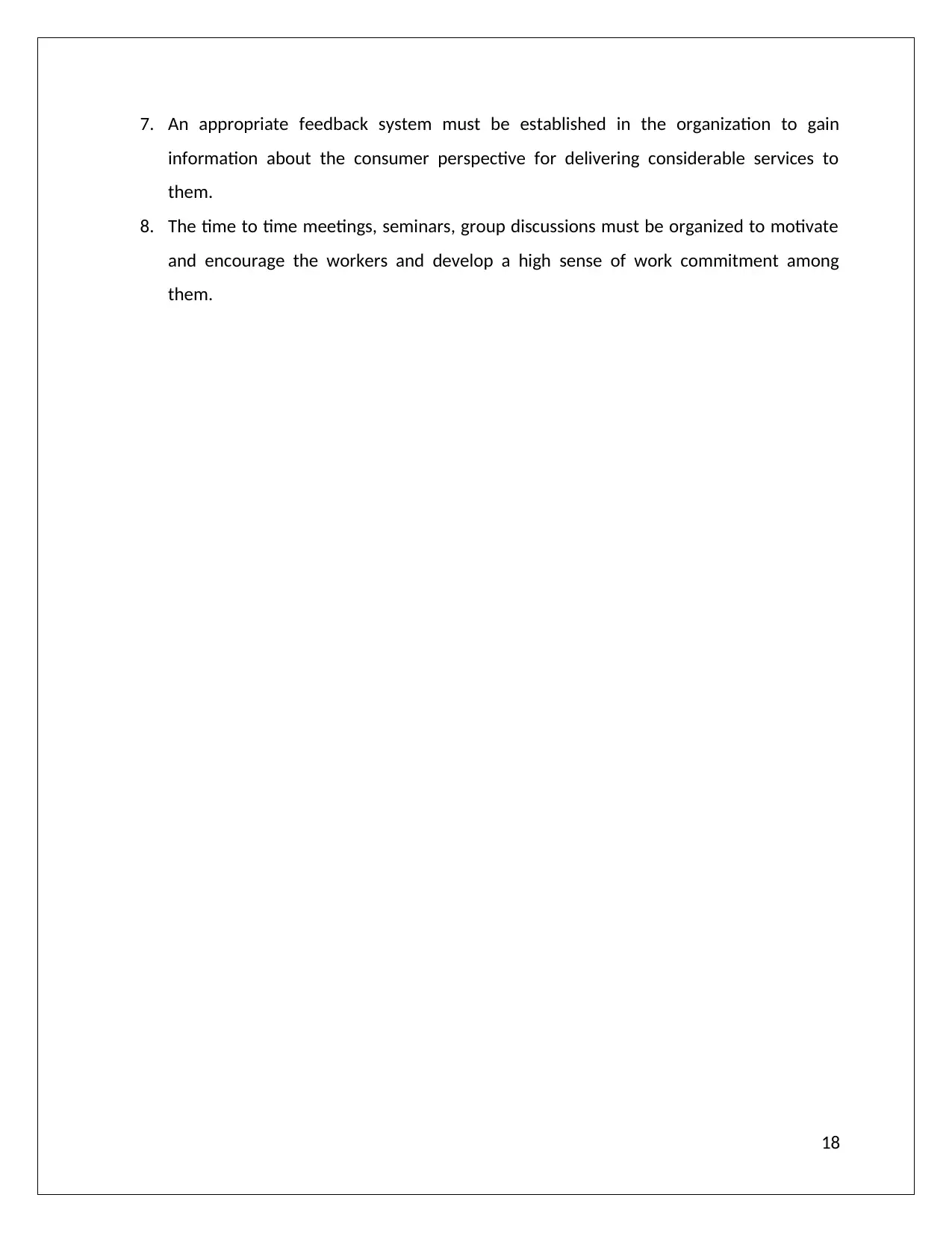
7. An appropriate feedback system must be established in the organization to gain
information about the consumer perspective for delivering considerable services to
them.
8. The time to time meetings, seminars, group discussions must be organized to motivate
and encourage the workers and develop a high sense of work commitment among
them.
18
information about the consumer perspective for delivering considerable services to
them.
8. The time to time meetings, seminars, group discussions must be organized to motivate
and encourage the workers and develop a high sense of work commitment among
them.
18
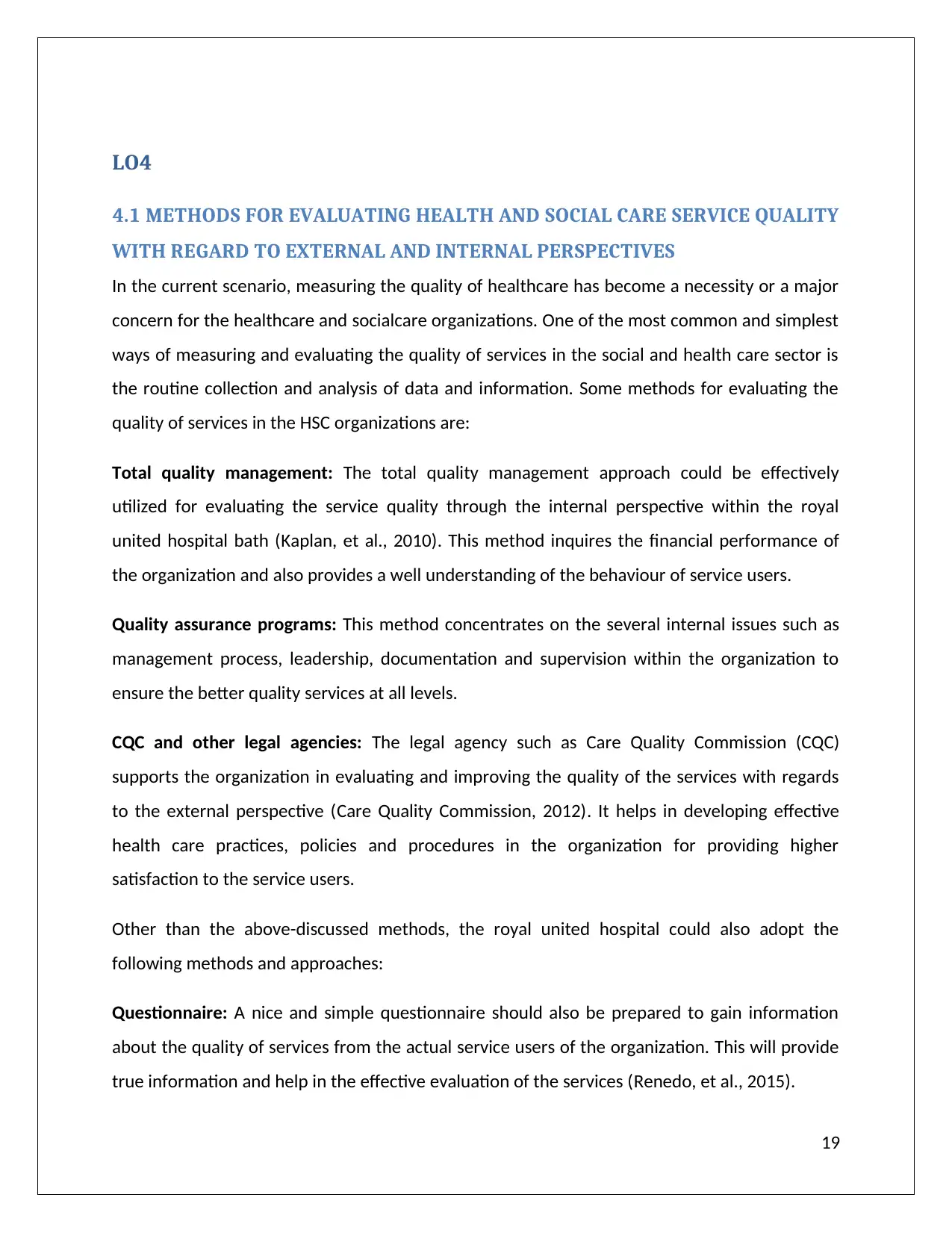
LO4
4.1 METHODS FOR EVALUATING HEALTH AND SOCIAL CARE SERVICE QUALITY
WITH REGARD TO EXTERNAL AND INTERNAL PERSPECTIVES
In the current scenario, measuring the quality of healthcare has become a necessity or a major
concern for the healthcare and socialcare organizations. One of the most common and simplest
ways of measuring and evaluating the quality of services in the social and health care sector is
the routine collection and analysis of data and information. Some methods for evaluating the
quality of services in the HSC organizations are:
Total quality management: The total quality management approach could be effectively
utilized for evaluating the service quality through the internal perspective within the royal
united hospital bath (Kaplan, et al., 2010). This method inquires the financial performance of
the organization and also provides a well understanding of the behaviour of service users.
Quality assurance programs: This method concentrates on the several internal issues such as
management process, leadership, documentation and supervision within the organization to
ensure the better quality services at all levels.
CQC and other legal agencies: The legal agency such as Care Quality Commission (CQC)
supports the organization in evaluating and improving the quality of the services with regards
to the external perspective (Care Quality Commission, 2012). It helps in developing effective
health care practices, policies and procedures in the organization for providing higher
satisfaction to the service users.
Other than the above-discussed methods, the royal united hospital could also adopt the
following methods and approaches:
Questionnaire: A nice and simple questionnaire should also be prepared to gain information
about the quality of services from the actual service users of the organization. This will provide
true information and help in the effective evaluation of the services (Renedo, et al., 2015).
19
4.1 METHODS FOR EVALUATING HEALTH AND SOCIAL CARE SERVICE QUALITY
WITH REGARD TO EXTERNAL AND INTERNAL PERSPECTIVES
In the current scenario, measuring the quality of healthcare has become a necessity or a major
concern for the healthcare and socialcare organizations. One of the most common and simplest
ways of measuring and evaluating the quality of services in the social and health care sector is
the routine collection and analysis of data and information. Some methods for evaluating the
quality of services in the HSC organizations are:
Total quality management: The total quality management approach could be effectively
utilized for evaluating the service quality through the internal perspective within the royal
united hospital bath (Kaplan, et al., 2010). This method inquires the financial performance of
the organization and also provides a well understanding of the behaviour of service users.
Quality assurance programs: This method concentrates on the several internal issues such as
management process, leadership, documentation and supervision within the organization to
ensure the better quality services at all levels.
CQC and other legal agencies: The legal agency such as Care Quality Commission (CQC)
supports the organization in evaluating and improving the quality of the services with regards
to the external perspective (Care Quality Commission, 2012). It helps in developing effective
health care practices, policies and procedures in the organization for providing higher
satisfaction to the service users.
Other than the above-discussed methods, the royal united hospital could also adopt the
following methods and approaches:
Questionnaire: A nice and simple questionnaire should also be prepared to gain information
about the quality of services from the actual service users of the organization. This will provide
true information and help in the effective evaluation of the services (Renedo, et al., 2015).
19
Paraphrase This Document
Need a fresh take? Get an instant paraphrase of this document with our AI Paraphraser
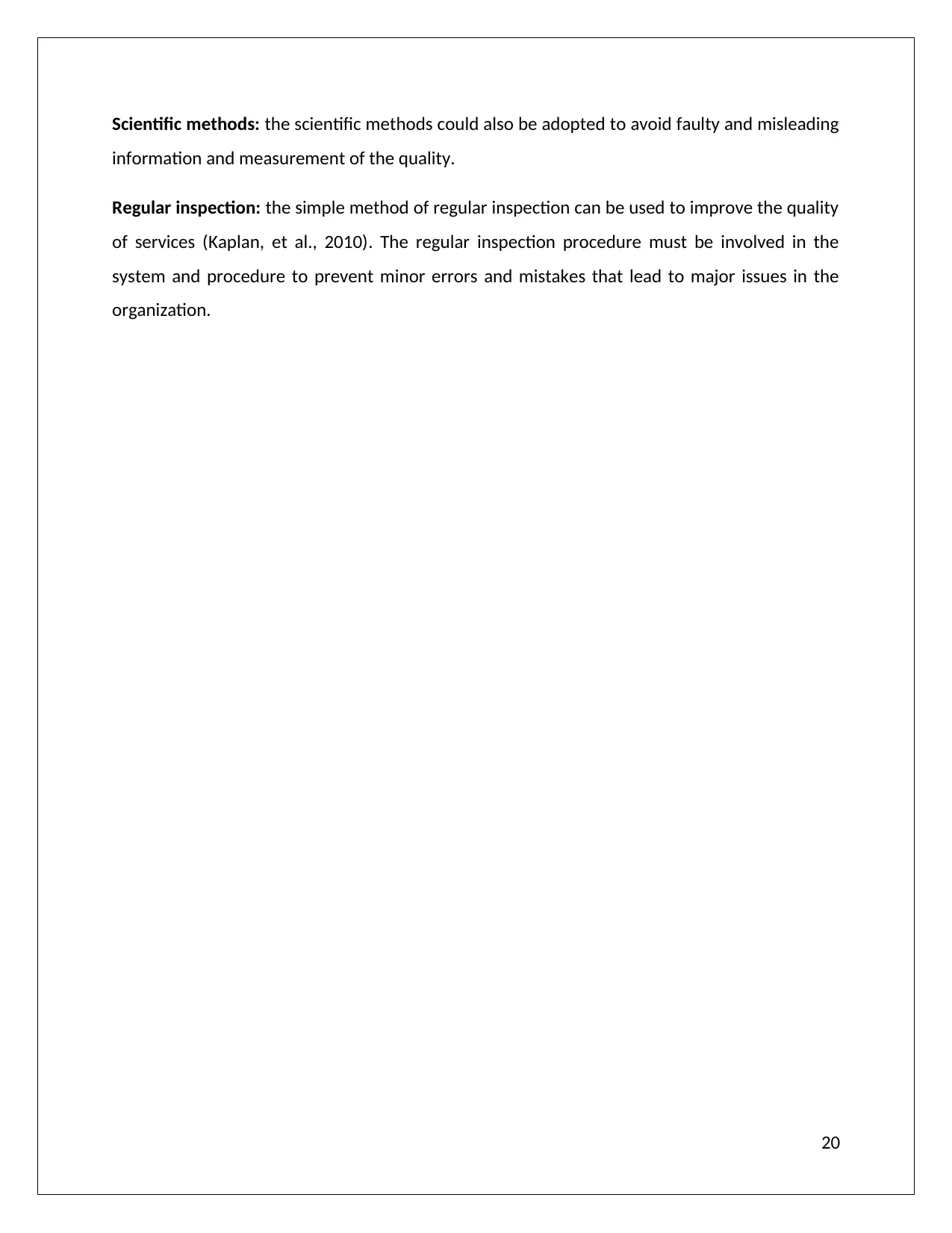
Scientific methods: the scientific methods could also be adopted to avoid faulty and misleading
information and measurement of the quality.
Regular inspection: the simple method of regular inspection can be used to improve the quality
of services (Kaplan, et al., 2010). The regular inspection procedure must be involved in the
system and procedure to prevent minor errors and mistakes that lead to major issues in the
organization.
20
information and measurement of the quality.
Regular inspection: the simple method of regular inspection can be used to improve the quality
of services (Kaplan, et al., 2010). The regular inspection procedure must be involved in the
system and procedure to prevent minor errors and mistakes that lead to major issues in the
organization.
20
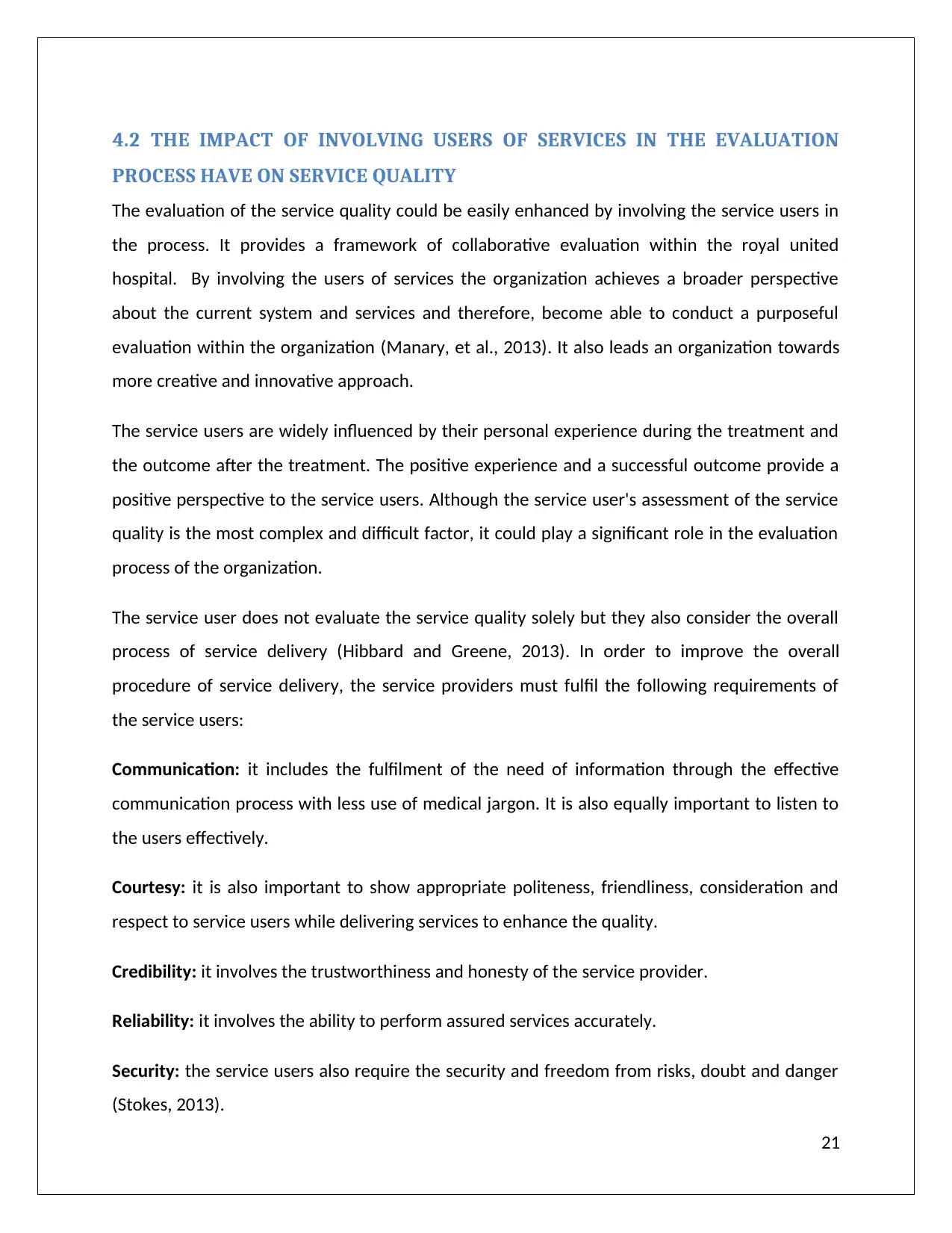
4.2 THE IMPACT OF INVOLVING USERS OF SERVICES IN THE EVALUATION
PROCESS HAVE ON SERVICE QUALITY
The evaluation of the service quality could be easily enhanced by involving the service users in
the process. It provides a framework of collaborative evaluation within the royal united
hospital. By involving the users of services the organization achieves a broader perspective
about the current system and services and therefore, become able to conduct a purposeful
evaluation within the organization (Manary, et al., 2013). It also leads an organization towards
more creative and innovative approach.
The service users are widely influenced by their personal experience during the treatment and
the outcome after the treatment. The positive experience and a successful outcome provide a
positive perspective to the service users. Although the service user's assessment of the service
quality is the most complex and difficult factor, it could play a significant role in the evaluation
process of the organization.
The service user does not evaluate the service quality solely but they also consider the overall
process of service delivery (Hibbard and Greene, 2013). In order to improve the overall
procedure of service delivery, the service providers must fulfil the following requirements of
the service users:
Communication: it includes the fulfilment of the need of information through the effective
communication process with less use of medical jargon. It is also equally important to listen to
the users effectively.
Courtesy: it is also important to show appropriate politeness, friendliness, consideration and
respect to service users while delivering services to enhance the quality.
Credibility: it involves the trustworthiness and honesty of the service provider.
Reliability: it involves the ability to perform assured services accurately.
Security: the service users also require the security and freedom from risks, doubt and danger
(Stokes, 2013).
21
PROCESS HAVE ON SERVICE QUALITY
The evaluation of the service quality could be easily enhanced by involving the service users in
the process. It provides a framework of collaborative evaluation within the royal united
hospital. By involving the users of services the organization achieves a broader perspective
about the current system and services and therefore, become able to conduct a purposeful
evaluation within the organization (Manary, et al., 2013). It also leads an organization towards
more creative and innovative approach.
The service users are widely influenced by their personal experience during the treatment and
the outcome after the treatment. The positive experience and a successful outcome provide a
positive perspective to the service users. Although the service user's assessment of the service
quality is the most complex and difficult factor, it could play a significant role in the evaluation
process of the organization.
The service user does not evaluate the service quality solely but they also consider the overall
process of service delivery (Hibbard and Greene, 2013). In order to improve the overall
procedure of service delivery, the service providers must fulfil the following requirements of
the service users:
Communication: it includes the fulfilment of the need of information through the effective
communication process with less use of medical jargon. It is also equally important to listen to
the users effectively.
Courtesy: it is also important to show appropriate politeness, friendliness, consideration and
respect to service users while delivering services to enhance the quality.
Credibility: it involves the trustworthiness and honesty of the service provider.
Reliability: it involves the ability to perform assured services accurately.
Security: the service users also require the security and freedom from risks, doubt and danger
(Stokes, 2013).
21
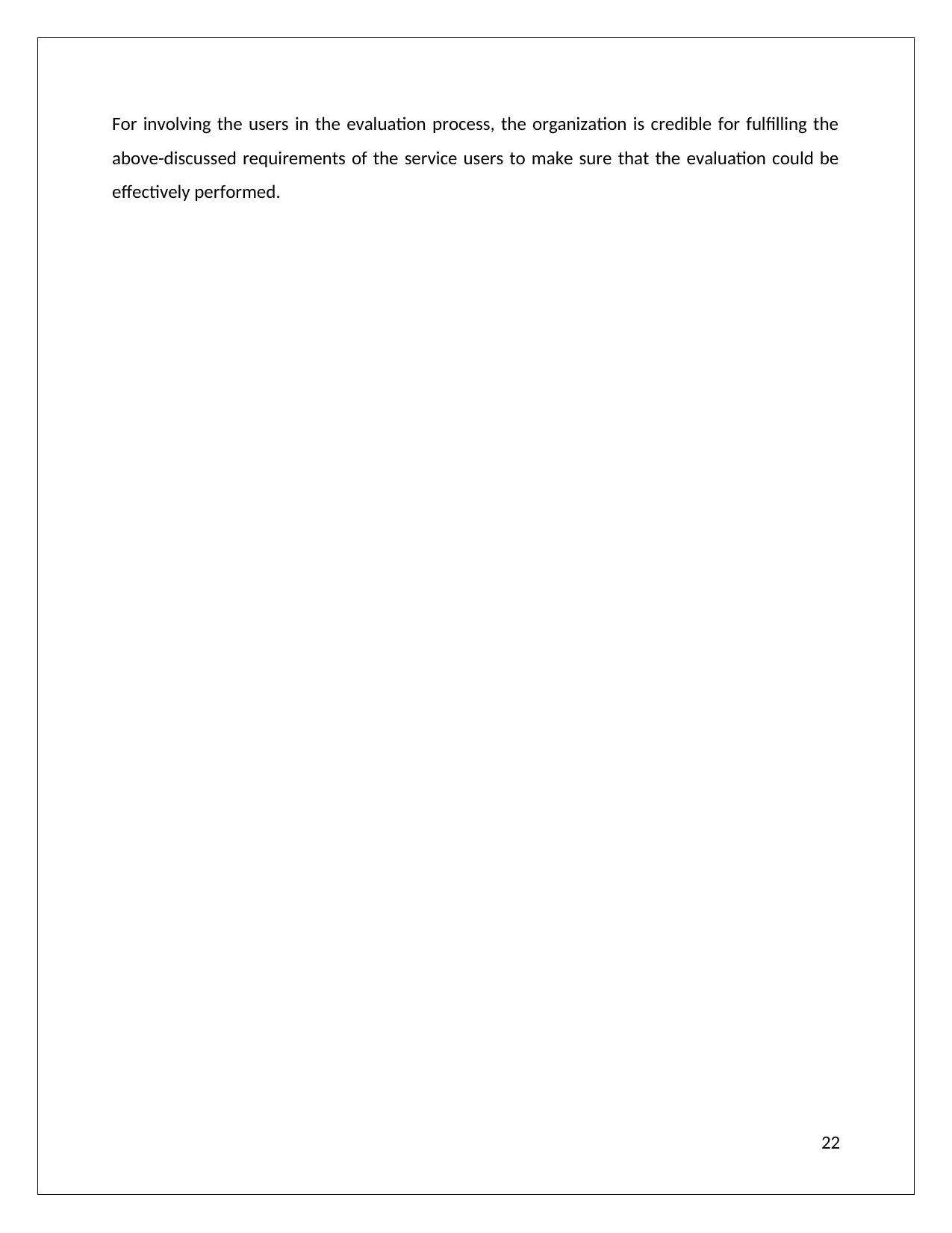
For involving the users in the evaluation process, the organization is credible for fulfilling the
above-discussed requirements of the service users to make sure that the evaluation could be
effectively performed.
22
above-discussed requirements of the service users to make sure that the evaluation could be
effectively performed.
22
Secure Best Marks with AI Grader
Need help grading? Try our AI Grader for instant feedback on your assignments.
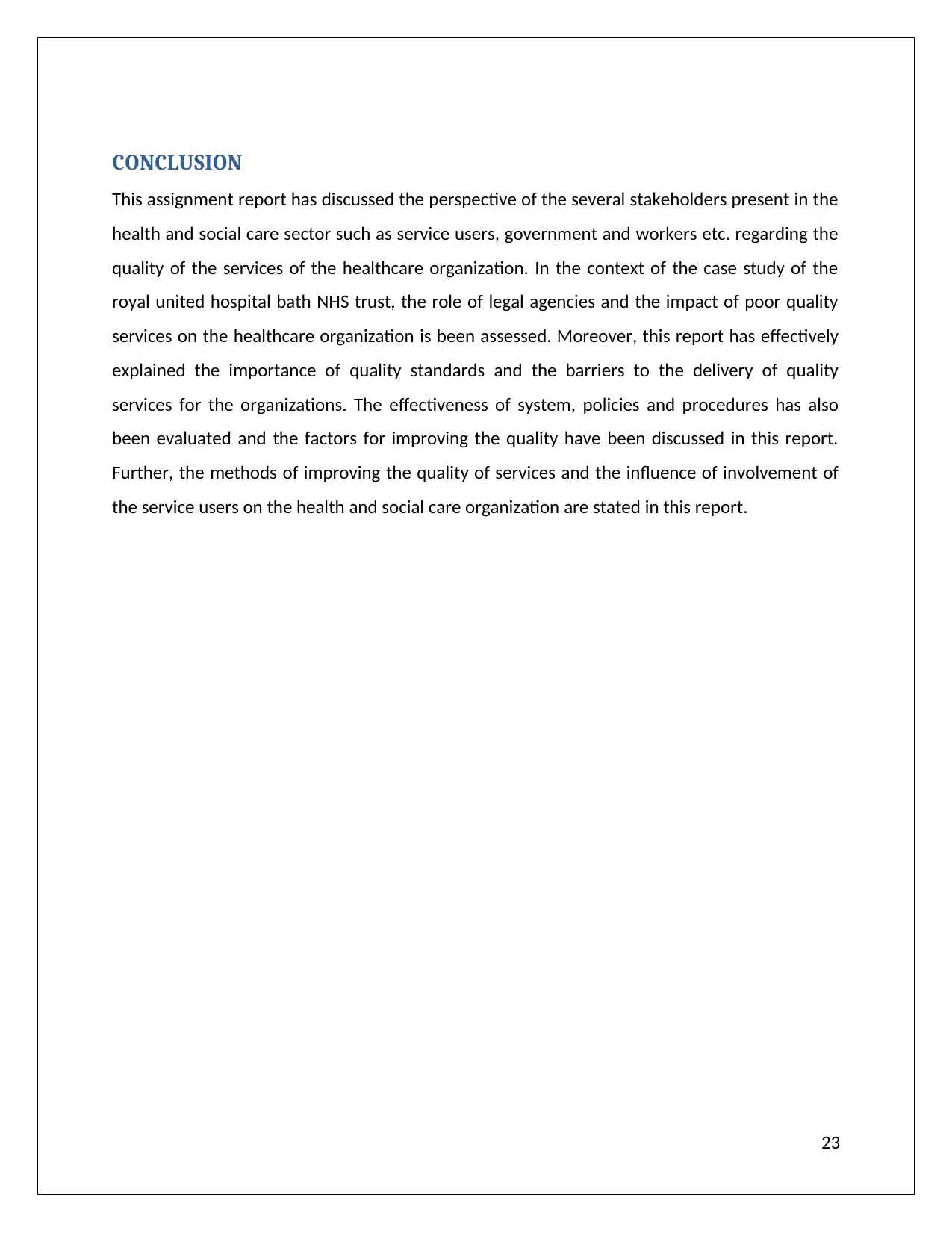
CONCLUSION
This assignment report has discussed the perspective of the several stakeholders present in the
health and social care sector such as service users, government and workers etc. regarding the
quality of the services of the healthcare organization. In the context of the case study of the
royal united hospital bath NHS trust, the role of legal agencies and the impact of poor quality
services on the healthcare organization is been assessed. Moreover, this report has effectively
explained the importance of quality standards and the barriers to the delivery of quality
services for the organizations. The effectiveness of system, policies and procedures has also
been evaluated and the factors for improving the quality have been discussed in this report.
Further, the methods of improving the quality of services and the influence of involvement of
the service users on the health and social care organization are stated in this report.
23
This assignment report has discussed the perspective of the several stakeholders present in the
health and social care sector such as service users, government and workers etc. regarding the
quality of the services of the healthcare organization. In the context of the case study of the
royal united hospital bath NHS trust, the role of legal agencies and the impact of poor quality
services on the healthcare organization is been assessed. Moreover, this report has effectively
explained the importance of quality standards and the barriers to the delivery of quality
services for the organizations. The effectiveness of system, policies and procedures has also
been evaluated and the factors for improving the quality have been discussed in this report.
Further, the methods of improving the quality of services and the influence of involvement of
the service users on the health and social care organization are stated in this report.
23
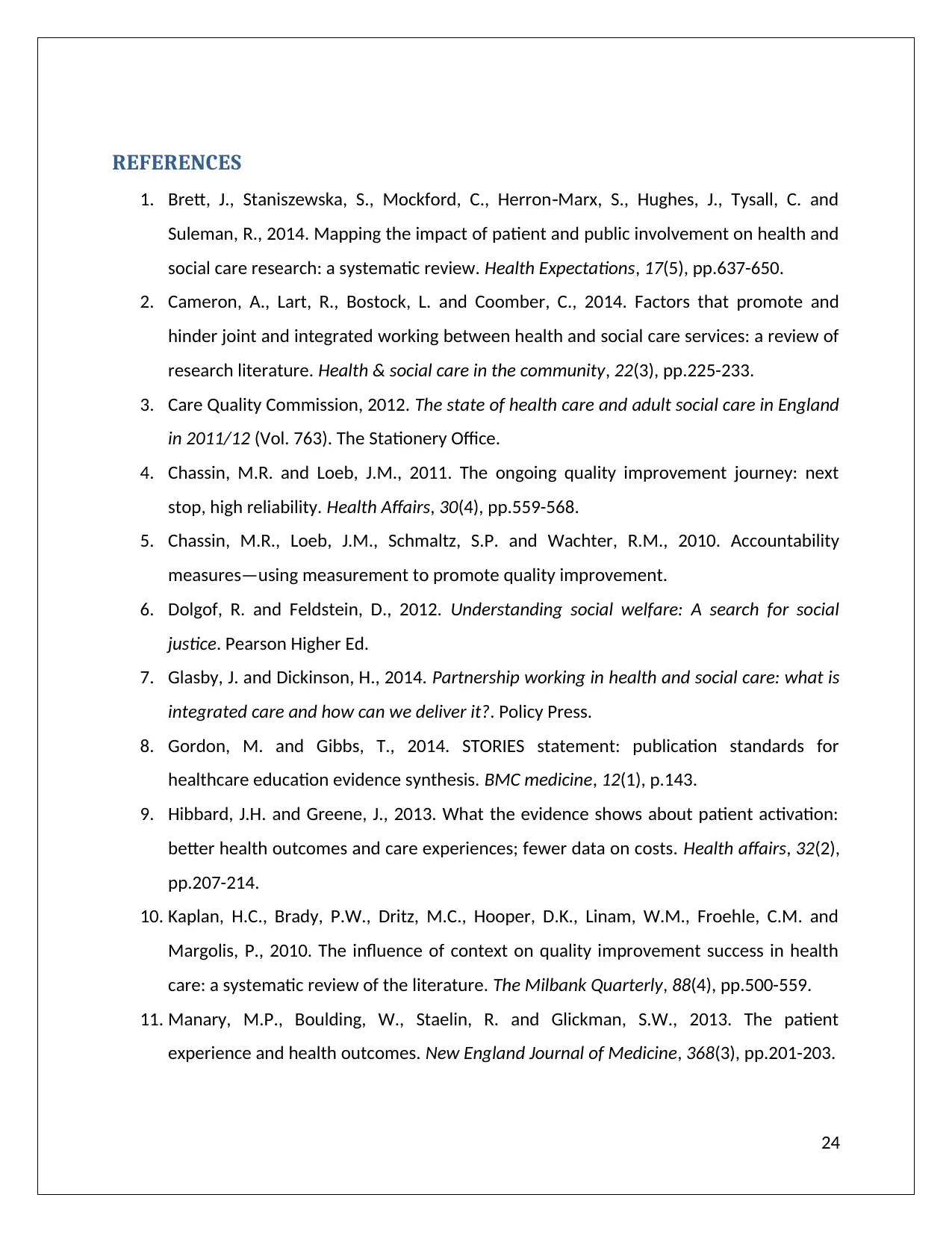
REFERENCES
1. Brett, J., Staniszewska, S., Mockford, C., Herron Marx, S., Hughes, J., Tysall, C. and‐
Suleman, R., 2014. Mapping the impact of patient and public involvement on health and
social care research: a systematic review. Health Expectations, 17(5), pp.637-650.
2. Cameron, A., Lart, R., Bostock, L. and Coomber, C., 2014. Factors that promote and
hinder joint and integrated working between health and social care services: a review of
research literature. Health & social care in the community, 22(3), pp.225-233.
3. Care Quality Commission, 2012. The state of health care and adult social care in England
in 2011/12 (Vol. 763). The Stationery Office.
4. Chassin, M.R. and Loeb, J.M., 2011. The ongoing quality improvement journey: next
stop, high reliability. Health Affairs, 30(4), pp.559-568.
5. Chassin, M.R., Loeb, J.M., Schmaltz, S.P. and Wachter, R.M., 2010. Accountability
measures—using measurement to promote quality improvement.
6. Dolgof, R. and Feldstein, D., 2012. Understanding social welfare: A search for social
justice. Pearson Higher Ed.
7. Glasby, J. and Dickinson, H., 2014. Partnership working in health and social care: what is
integrated care and how can we deliver it?. Policy Press.
8. Gordon, M. and Gibbs, T., 2014. STORIES statement: publication standards for
healthcare education evidence synthesis. BMC medicine, 12(1), p.143.
9. Hibbard, J.H. and Greene, J., 2013. What the evidence shows about patient activation:
better health outcomes and care experiences; fewer data on costs. Health affairs, 32(2),
pp.207-214.
10. Kaplan, H.C., Brady, P.W., Dritz, M.C., Hooper, D.K., Linam, W.M., Froehle, C.M. and
Margolis, P., 2010. The influence of context on quality improvement success in health
care: a systematic review of the literature. The Milbank Quarterly, 88(4), pp.500-559.
11. Manary, M.P., Boulding, W., Staelin, R. and Glickman, S.W., 2013. The patient
experience and health outcomes. New England Journal of Medicine, 368(3), pp.201-203.
24
1. Brett, J., Staniszewska, S., Mockford, C., Herron Marx, S., Hughes, J., Tysall, C. and‐
Suleman, R., 2014. Mapping the impact of patient and public involvement on health and
social care research: a systematic review. Health Expectations, 17(5), pp.637-650.
2. Cameron, A., Lart, R., Bostock, L. and Coomber, C., 2014. Factors that promote and
hinder joint and integrated working between health and social care services: a review of
research literature. Health & social care in the community, 22(3), pp.225-233.
3. Care Quality Commission, 2012. The state of health care and adult social care in England
in 2011/12 (Vol. 763). The Stationery Office.
4. Chassin, M.R. and Loeb, J.M., 2011. The ongoing quality improvement journey: next
stop, high reliability. Health Affairs, 30(4), pp.559-568.
5. Chassin, M.R., Loeb, J.M., Schmaltz, S.P. and Wachter, R.M., 2010. Accountability
measures—using measurement to promote quality improvement.
6. Dolgof, R. and Feldstein, D., 2012. Understanding social welfare: A search for social
justice. Pearson Higher Ed.
7. Glasby, J. and Dickinson, H., 2014. Partnership working in health and social care: what is
integrated care and how can we deliver it?. Policy Press.
8. Gordon, M. and Gibbs, T., 2014. STORIES statement: publication standards for
healthcare education evidence synthesis. BMC medicine, 12(1), p.143.
9. Hibbard, J.H. and Greene, J., 2013. What the evidence shows about patient activation:
better health outcomes and care experiences; fewer data on costs. Health affairs, 32(2),
pp.207-214.
10. Kaplan, H.C., Brady, P.W., Dritz, M.C., Hooper, D.K., Linam, W.M., Froehle, C.M. and
Margolis, P., 2010. The influence of context on quality improvement success in health
care: a systematic review of the literature. The Milbank Quarterly, 88(4), pp.500-559.
11. Manary, M.P., Boulding, W., Staelin, R. and Glickman, S.W., 2013. The patient
experience and health outcomes. New England Journal of Medicine, 368(3), pp.201-203.
24
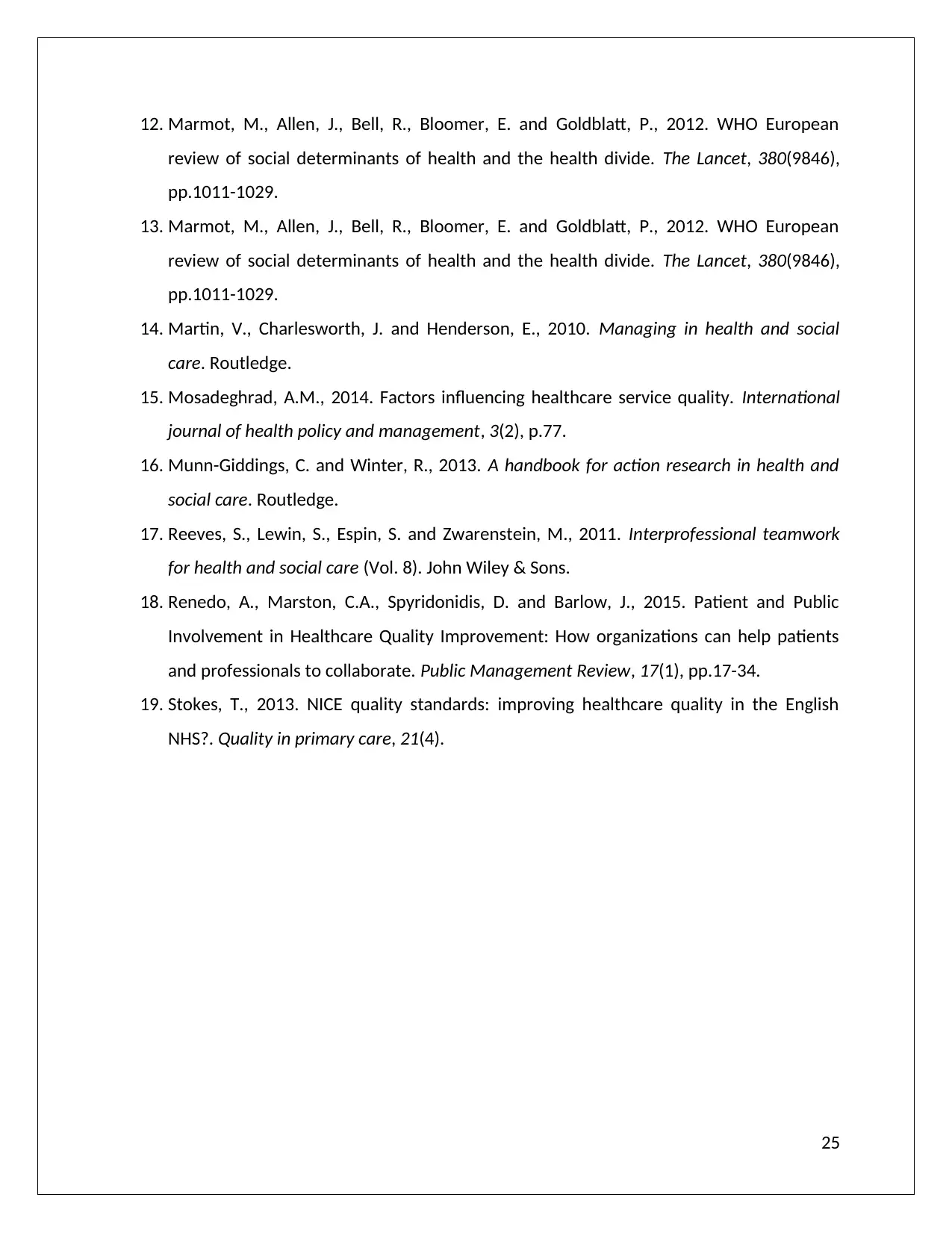
12. Marmot, M., Allen, J., Bell, R., Bloomer, E. and Goldblatt, P., 2012. WHO European
review of social determinants of health and the health divide. The Lancet, 380(9846),
pp.1011-1029.
13. Marmot, M., Allen, J., Bell, R., Bloomer, E. and Goldblatt, P., 2012. WHO European
review of social determinants of health and the health divide. The Lancet, 380(9846),
pp.1011-1029.
14. Martin, V., Charlesworth, J. and Henderson, E., 2010. Managing in health and social
care. Routledge.
15. Mosadeghrad, A.M., 2014. Factors influencing healthcare service quality. International
journal of health policy and management, 3(2), p.77.
16. Munn-Giddings, C. and Winter, R., 2013. A handbook for action research in health and
social care. Routledge.
17. Reeves, S., Lewin, S., Espin, S. and Zwarenstein, M., 2011. Interprofessional teamwork
for health and social care (Vol. 8). John Wiley & Sons.
18. Renedo, A., Marston, C.A., Spyridonidis, D. and Barlow, J., 2015. Patient and Public
Involvement in Healthcare Quality Improvement: How organizations can help patients
and professionals to collaborate. Public Management Review, 17(1), pp.17-34.
19. Stokes, T., 2013. NICE quality standards: improving healthcare quality in the English
NHS?. Quality in primary care, 21(4).
25
review of social determinants of health and the health divide. The Lancet, 380(9846),
pp.1011-1029.
13. Marmot, M., Allen, J., Bell, R., Bloomer, E. and Goldblatt, P., 2012. WHO European
review of social determinants of health and the health divide. The Lancet, 380(9846),
pp.1011-1029.
14. Martin, V., Charlesworth, J. and Henderson, E., 2010. Managing in health and social
care. Routledge.
15. Mosadeghrad, A.M., 2014. Factors influencing healthcare service quality. International
journal of health policy and management, 3(2), p.77.
16. Munn-Giddings, C. and Winter, R., 2013. A handbook for action research in health and
social care. Routledge.
17. Reeves, S., Lewin, S., Espin, S. and Zwarenstein, M., 2011. Interprofessional teamwork
for health and social care (Vol. 8). John Wiley & Sons.
18. Renedo, A., Marston, C.A., Spyridonidis, D. and Barlow, J., 2015. Patient and Public
Involvement in Healthcare Quality Improvement: How organizations can help patients
and professionals to collaborate. Public Management Review, 17(1), pp.17-34.
19. Stokes, T., 2013. NICE quality standards: improving healthcare quality in the English
NHS?. Quality in primary care, 21(4).
25
1 out of 25
Related Documents
Your All-in-One AI-Powered Toolkit for Academic Success.
+13062052269
info@desklib.com
Available 24*7 on WhatsApp / Email
![[object Object]](/_next/static/media/star-bottom.7253800d.svg)
Unlock your academic potential
© 2024 | Zucol Services PVT LTD | All rights reserved.





